History of the Discovery and Appreciation of Pearls - the Organic Gem Perfected by Nature - Page 8
Open FREE Unlimited Store Join Our Newsletter
The Use and Appreciation of Pearls by the monarchies of Spain and Portugal during the middle ages and until modern times
In the previous webpage the use and appreciation of pearls by the monarchies of France and the United Kingdom from the middle ages to modern times were considered in detail. In France, the monarchies considered belonged to the House of Bourbon that ruled from 1589 until the revolution in 1792, and again when it was restored from 1815 to 1830; the House of Orleans, the lesser branch of the House of Bourbon, whose only monarch Louis Philippe ruled from 1830 to 1848; and the emperors of the House of Bonaparte who ruled first from 1804 to 1814 and then from 1852 to 1870. In the United Kingdom, the monarchies considered belonged to the House of Hanover, that ruled from 1714 to 1901; the House of Saxe-Coburg and Gotha, whose only ruler, Edward VII ruled from 1901 to 1910 and the House of Windsor, who ruled from 1910 onwards, and to which house the present constitutional monarch of Great Britain, Queen Elizabeth II belongs. In the present webpage, which is part 8 of the series of webpages dealing with the history of the discovery and appreciation of pearls, the use and appreciation of pearls by the monarchies of Spain and Portugal in the middle ages and until modern times will be considered in detail, using the same approach as the previous webpage, making use of colored portraits of monarchs and their spouses, executed by renowned portrait painters of the period, who have left us a wealth of information on the mode of dressing, the styles adopted, the materials used for their royal robes and apart from the crowns and other royal insignia, the types of ornaments worn by the monarchs and their spouses during this period. As it was clearly brought out in the previous webpage, the single most popular type of jewelry among members of the royal families of Europe during this period and upto modern times, were those incorporating natural pearls, such as necklaces, brooches, bracelets, earrings, head ornaments etc.
The Use and Appreciation of Pearls by the Monarchies of the Kingdom of Spain from 1516 to 1873 and again from 1874 to 1931
The country of Spain as we know it today and the Kingdom of Spain that ruled over it came into existence in the early 16th-century. Two of the largest kingdoms, Aragon and Castile joined together in the late 15th-century to form a single dominion, a union facilitated by the marriage of Ferdinand II of Aragon and Isabella I of Castile. The southern part of Navarre was also incorporated into this union, that came to be known as Spain, after the region was captured by Ferdinand. Queen Isabella left her kingdom to her daughter Joanna of Castile, and due to bouts of insanity suffered by her, her father Ferdinand and later her husband, Philip, the Handsome were appointed as her regent. When Philip died in 1506 Ferdinand resumed the regency again. After Ferdinand II's death in 1516, his kingdom Aragon was inherited by his insane daughter Joanna, but due to her inability to rule, her son Charles I was proclaimed King of Castile and Aragon, jointly with his mother.
The use and appreciation of pearls by the monarchies of the Kingdom of Spain is considered beginning from the reign of King Charles I in 1516 until the reign of the present King of Spain Juan Carlos I who ascended the throne in 1975. During this period Spain was ruled by the monarchs of several dynasties, such as the House of Hapsburg (1516 to 1700); the House of Bourbon (1700-1808); House of Bonaparte (1808-1813); House of Bourbon - First Restoration (1813-1868); House of Savoy (1870-1873); House of Bourbon - Second Restoration (1874-1931); House of Bourbon - Third Restoration - (1975 - to date). Each of these dynasties will now be considered in detail.
Appreciation of pearls by the spouses of the monarchs of the House of Hapsburg (1516-1700)
Isabella of Portugal - Wife and Queen Consort of King Charles I & V, Holy Roman Emperor, Duke of Burgundy and King of Spain from 1516 to 1556
Charles I is considered as the first King of Spain as he was the first person to rule both Castile-Leon and Aragon simultaneously in his own right, beginning from 1516. Besides this in 1506, when his father, Philip the Handsome died, he inherited his father's Duchy of Burgundy. Again in 1519, when his paternal grandfather, Maximilian died, he succeeded him both as Archduke of Austria and as the Holy Roman Emperor (Charles V). Thus, as the heir to the Crown of Castile-Leon and Aragon, the Habsburg monarchy of Austria and the Duchy of Burgundy, Charles presided over an empire, that was the largest in extent in the World at that time, covering an area of approximately 4 million square kilometers that included not only Europe, but also the newly colonized territories in the New World and the Far East, earning the popular epithet of "the empire on which the sun never sets."
Isabella was the daughter of Manuel I of Portugal and his second spouse, Infanta Maria of Castile and Aragon, a daughter of Isabella I of Castile and Ferdinand II of Aragon and sister of Joanna of Castile. Thus, she was the first cousin of Charles I & V, the Holy Roman Emperor, Duke of Burgundy and King of Spain. Isabella, who was noted for her beauty and intelligence, married King Charles I & V on March 11, 1526. The marriage proved to be a successful one, producing seven children of whom three survived into adulthood. Isabella died in 1539, soon after the birth of her 7th-child. The premature death of his queen, at the time he was away from Spain, affected the king very deeply, that he never remarried and dressed in black for the rest of his life.
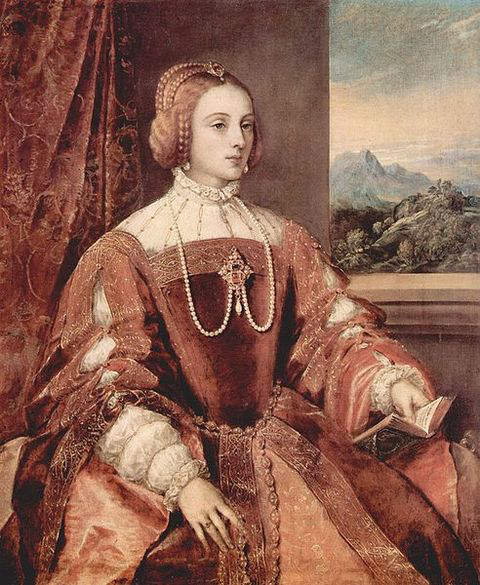
Isabella of Portugal - Queen Consort of King Charles I & V Holy Roman Empeor, Duke of Burgundy and King of Spain
Ornaments worn -
1) Stomacher set with pearls and colored stones, and a drop-shaped pearl hanging from it.
2) Single-strand pearl necklace, with its ends connected in front to the sides of the stomacher to form a double-loop.
3) Pearl drop-earrings.
4) Hair ornament set with drop-shaped pearls.
5) Pearl-encrusted dress.
6) Beaded belt also incoporating pearls.
Portrait by - Italian painter Titian in 1548.
Maria Manuela of Portugal - First wife (1544-1545) of Philip, Prince of Asturias, the future Philip II of Spain
Charles I & V abdicated in 1556, due to ill health, in favor of his son Philip II and younger brother, Ferdinand. Philip II inherited the Spanish empire and Ferdinand the Habsburg monarchy.
During his lifetime Philip II married four times. His first wife was his double first cousin, Maria Manuela of Portugal, daughter of King John III of Portugal and his wife Catherine of Austria, whom he married in 1544, when he was Prince of Asturias. Maria Manuela died soon after she gave birth to her first child, a son, the deformed Infante Carlos of Spain, on August 12, 1545.
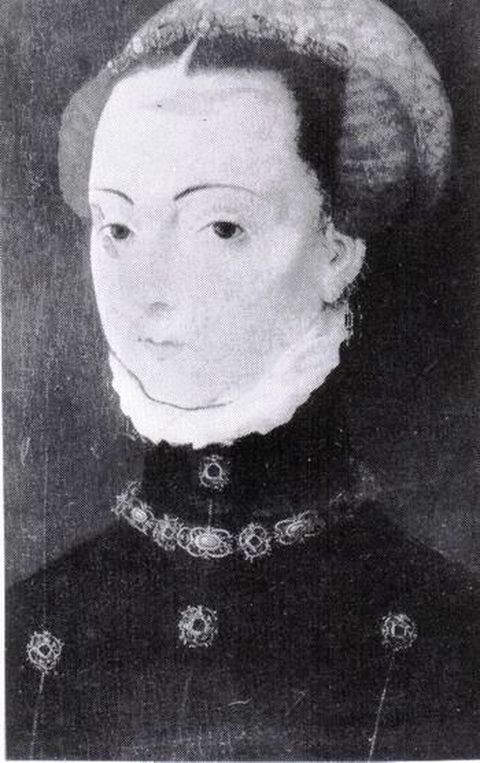
Maria Manuela - Princess of Portugal and Asturias - first wife of Philip, Prince of Asturias (future Philip II of Spain)
Ornaments worn -
Headdress incorporating pearls.
Necklace incorporating pearls and colored stones.
Brooches incorporating colored stones.
Drop-earrings incorporating colored stones.
Queen Mary I of England - Second wife (1554-1558) of King Philip II of Spain, Portugal, Spanish Netherlands, Naples and Duke of Burgundy and Milan, from 1556 to 1598
Philip's second wife, whom he married in 1554, before he ascended the throne of the Spanish empire in 1556, was his first cousin, Queen Mary I of England. Philips's father, Charles I & V, ceded the Crown of Naples to his son, in order to elevate him to Mary's rank. After the marriage, Philip became the joint ruler of England with his wife Queen Mary I. After, Philip ascended the Spanish throne in 1556, as Philip II, Mary became the Queen Consort of Spain. However, Philip and Mary lived apart more, than they were together, as each of them were busy ruling their respective domains. The marriage produced no children, and Queen Mary died in 1558.

Mary Tudor at the age of six years
Ornaments worn -
Pearl rope twisted into a double strand.
Head band with single strand of pearls.
Cross set with colored stones and three drop-shaped pearls hanging from it.
Rectangular brooch surrounded by a row of pearls with an inscription in the middle.
Portrait by - Lucas Horenbout
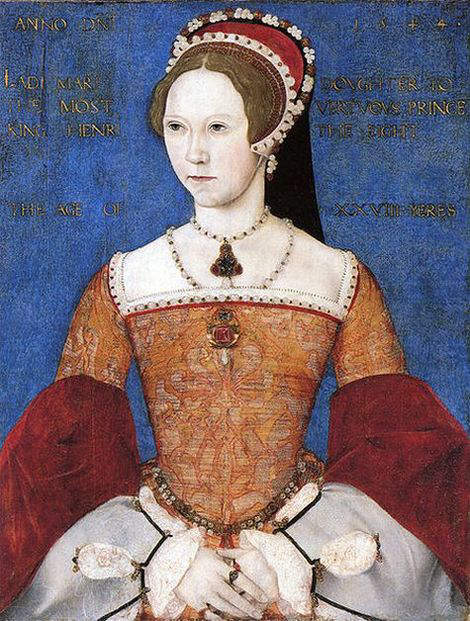
1544-Portrait of Mary I by Master John
Ornaments worn -
Head band with single strand of pearls.
Head band with clusters of pearls alternating with colored stones.
Earrings with clusters of pearls.
Choker length necklace with pearls and colored stones, and a bell-shaped centerpiece also set with pearls and colored stones.
A second longer necklace set with pearls and colored stones.
Neckline of dress set with pearls and colored stones.
Brooch set with colored stones and a drop-shaped pearl hanging from it.
Belt encrusted with pearls and colored stones.
Portrait by - Master John in 1544.
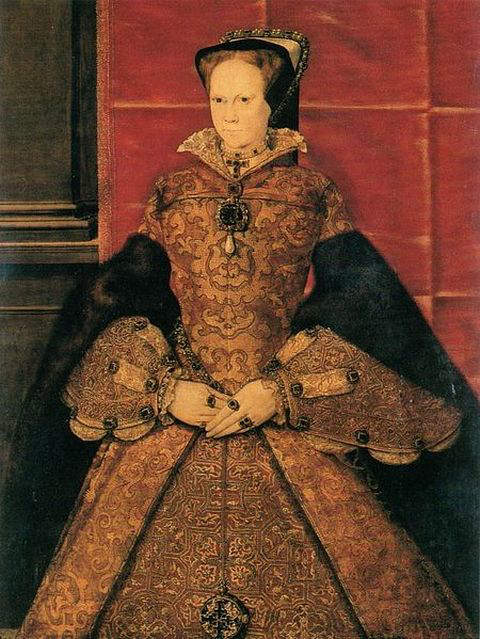
1554-Portrait of Mary I by Hans Eworth
Ornaments worn -
A head band with alternating pearls and colored stones.
Two-strand pearl necklace whose centerpiece is a cross set with pearls.
Brooch set with two large diamonds and the famous drop-shaped La Peregrina pearl hanging from it.
Large sleeves of dress encrusted with colored stones.
Rings set with colored stones.
A second brooch on the lower part of the dress, set with colored stones.
Portrait by - Hans Eworth

Portrait of Mary I by unknown artist around 1555
Ornaments worn -
Head band with alternating pearls and colored stones.
Two-strand pearl choker necklace interspersed with colored stones, whose centerpiece is a cross set with colored stones.
Pendant brooch set with diamonds and pearls and the drop-shaped La Peregrina hanging from it.
Portrait by - Unknown artist
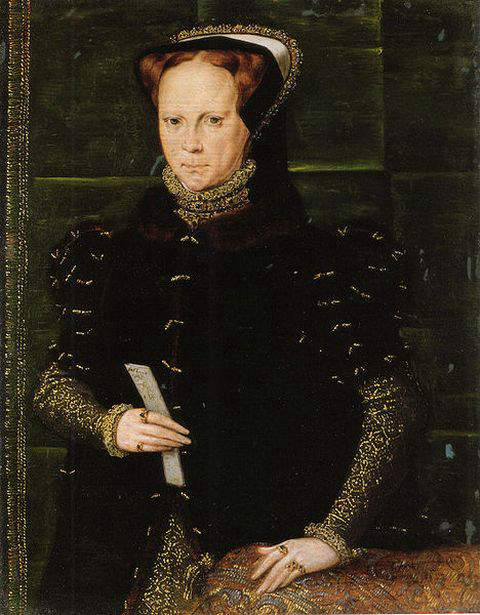
Portrait of Mary I by Hans Eworth painted around 1555 to 1558
Ornaments worn -
Head band encrusted with seed pearls and colored stones.
Neck bands encrusted with seed pearls and colored stones.
Wrist bands encrusted with seed pearls and colored stones.
Dress encrusted with seed pearls, particularly the long sleeves.
Portrait by - Hans Eworth, between 1555-1558.
Elizabeth of Valois - Third wife (1559-1568) of King Philip II of Spain, Portugal, Spanish Netherlands, Naples, Sicily and Duke of Burgundy and Milan from 1556 to 1598
In 1559, Philip II took his third wife, the young Elizabeth of Valois, the eldest daughter of Henry II of France and Catherine de Medici. Elizabeth was 14 and Philip II, 32 years of age at the time of the marriage. Despite the age difference, the marriage proved to be a successful one producing five children, of whom two survived into adulthood. Her first pregnancy ended with a miscarrige of twin girls in 1564. Her last pregnancy also ended with a miscarriage of an infant girl, in 1568, and Elizabeth died soon afterwards. Philip II was said to be very much attached to Elizabeth, doing everything possible to keep his young wife happy, such as hosting chivalric tournaments. His attachement to the Queen was clearly demonstrated when he decided to stay close by her side, at the time she fell ill with smallpox.

Elizabeth of Valois - Third wife of King Philip II of Spain
Ornaments worn -
Headdress encrusted with spherical pearls and colored stones, and a large drop-shaped pearl hanging from behind.
Two-strand pearl necklace, consisting of large spherical pearls.
Black velvet dress encrusted with colored stones and pearls, around the neck, the midline and along a V-shaped line extending from the hip region to the shoulders.
A V-shaped belt encrusted alternately with pearls and colored stones.
Exposed red sleeve encrusted with seed pearls.
Inverted V-shaped brooches on the front lower part of the dress and the left sleeves, set with pearls and carrying a bow at the top.
The Queen's right arm is resting on a court armchair, and in her hands she is holding an elegant gold chain set with colored stones, and ending in a gold pendant in the form of an animal head.
Portrait by - Juan Pantoja de la Cruz in 1605
Anna of Austria - Fourth wife (1570-1580) of King Philip II of Spain, Portugal, Spanish Netherlands, Naples, Sicily and Duke of Burgundy and Milan from 1556 to 1598
In 1570, Philip II took his 4th and last wife, Anna of Austria, the eldest daughter of Maximilian II, Holy Roman Emperor and Maria of Spain, his sister. Thus, Anna of Austria was his own niece. Anna's parents agreed to the marriage for the links it would create between the Austrian and Spanish Habsburg families. Anna became Philip's most beloved wife, and a good stepmother to Philip's young daughters by his previous marriage to Elizbeth of Valois. The marriage produced five children, four sons and one daughter, of whom only one son survived into adulthood and succeeded his father, as Philip III.
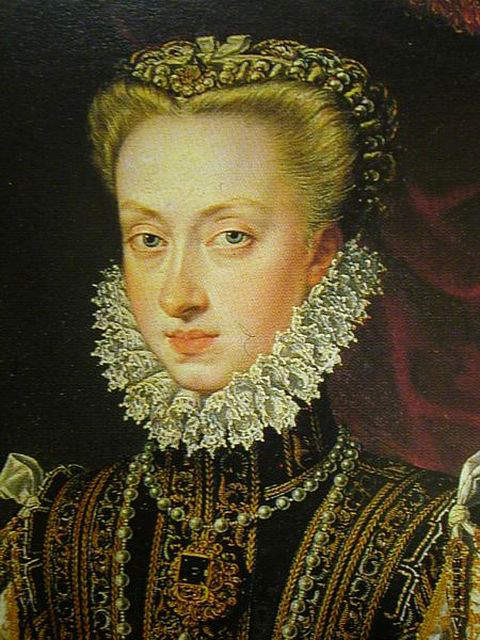
Anna of Austria - Fourth wife of Philip II of Spain
Ornaments worn -
Long pearl rope twisted around itself to form a double-strand necklace.
Head band set with pearls.
Portrait by - Sanchez Coello Alonso in 1571
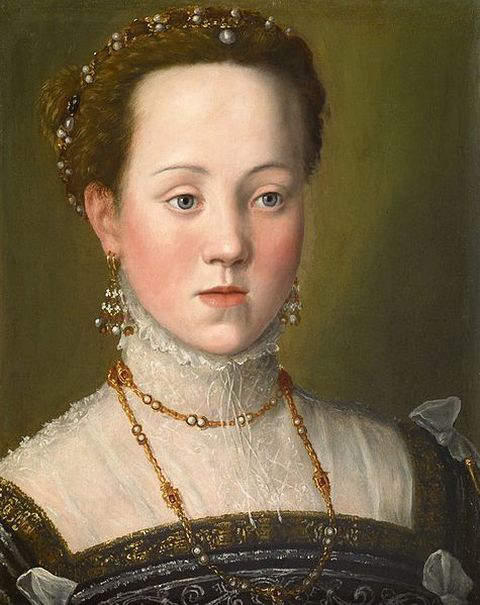
1563-portrait of Anna of Austria by Arcimboldo Giuseppe
Ornaments worn -
Headband made of spherical and drop-shaped pearls.
Drop-earrings made of pearls and colored stones.
Gold chain necklace set intermittently with pairs of spherical pearls and colored stones.
Portrait by - Arcimboldo Giuseppe
Margaret of Austria - Wife and Queen Consort of Philip III, King of Spain and Portugal from 1598 to 1621
Spain reached the peak of its power under Philip II, enriched by the great quantities of gold and silver flowing into its coffers from the mines in the New World, and the riches of the Portuguese spice trade. Philip II died in September 1598, after he was incapacitated by a severe attack of gout, fever and dropsy. He was succeeded by his only surviving son by his fourth wife, Anna of Austria, who ascended the throne as Philip III.
Philip III married his cousin, Margaret of Austria in 1599. Margaret was the daughter of Archduke Charles II of Austria and Maria Anna of Bavaria. Her elder brother was the future Archduke Ferdinand II, who succeeded as Emperor in 1619. Philip III's relationship with Margaret was very close and affectionate and Margaret bore him a son in 1605, after which the king paid her additional attention. The marriage of Margaret and Philip produced eight children of whom five survived into adulthood. Margaret died in 1611, while giving birth to her youngest child, Alfonso. Philip III never remarried and died 10 years later in 1621.

Margaret of Austria - Wife and Queen Consort of Philip III of Spain
Ornaments worn -
Headdress with drop-shaped pearl spikes.
Pearl drop-earrings.
Jewel encrusted dress.
Portrait by - Bartolome Gonzalez y Serrano in 1609
Elizabeth of France - First wife (1615-1644) and Queen consort of Philip IV, King of Spain from 1621-1665 and Portugal 1621-1640
Philip III was succeeded by his eldest son, who ascended the throne in 1621 as Philip IV. He reigned as the King of Spain and the Spanish Netherlands until his death in 1665, and as the King of Portugal until 1640. During his rule the Spanish empire reached its greatest extent in the 17th-century. Philip IV is remembered for his patronage of the Arts, including such artists as Diego Velazquez.
In 1615, when Philip IV was the Prince of Asturias and just 10 years old, he was married to Elizabeth of France who was 13 years of age.This was part of a double marriage, between the royal families of Spain and France, in which Philip, the Prince of Asturias would marry Elizabeth, the eldest daughter of King Henry IV of France and his second spouse Marie de Medici, and his sister Infanta Anne would marry Elizabeth's brother, the future king Louis XIII of France. The aim of this double royal marriage was to consolidate the political and military alliances between the two Catholic powers of France and Spain. Philip and Elizabeth had their first child only in 1621, the same year the couple ascended the throne as the King and Queen consort of Spain, after the death of Philip III. The couple subsequently had six more children, out of whom only two survived into adulthood, the fifth child, a son, Balthasar Charles, who became the Prince of Asturias and the heir to the throne, and the seventh and last child Infanta Maria Theresa of Spain, the future wife and Queen consort of Louis XIV of France. Elizabeth, who was renowned for her beauty, intelligence and noble personality, became very popular with the people of Spain. The renowned artist of the period, Diego Velazquez, who received royal patronage, painted several portraits of the Queen, some of which are reproduced below.
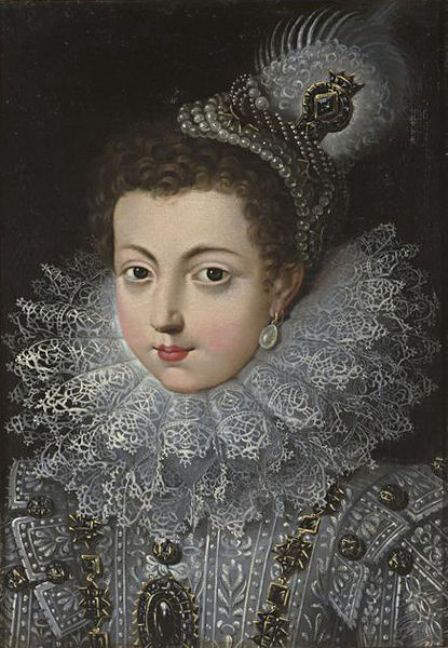
Elizabeth, daughter of Henry IV of France and Marie de Medici, as a young girl in France before her marriage
Ornaments worn -
Headdress decorated with large spherical pearls and small seed pearls.
Pearl drop-earrings.
Dress encrusted with pearls and colored stones.
Portrait by - Unknown Artist

Elizabeth, wife and Queen Consort of Philip IV, King of Spain - Portrait by Velazquez in 1625
Ornaments worn -
Hair ornament set with pearls.
Pearl encrusted dress.
Portrait by - Diego Velazquez around 1625.

Elizabeth of France by Diego Velazquez in 1632
Ornaments worn -
Hair ornament set with pearls.
Triple-strand pearl rope extending from the right shoulder to the left armpit, and twisted round the left arm.
A vertical row of pearls along the midline of her dress.
Pearl bracelets on both wrists.
Portrait by - Diego Velazquez in 1632

Formal portrait of Elizabeth of France by Diego Velazquez painted between 1630 to 1644
Ornaments worn -
Elaborate pearl-encrusted dress.
Pearl bracelets.
Pearls hanging from below the hairdo.
Portrait by- Diego Velazquez between 1630 and 1644.
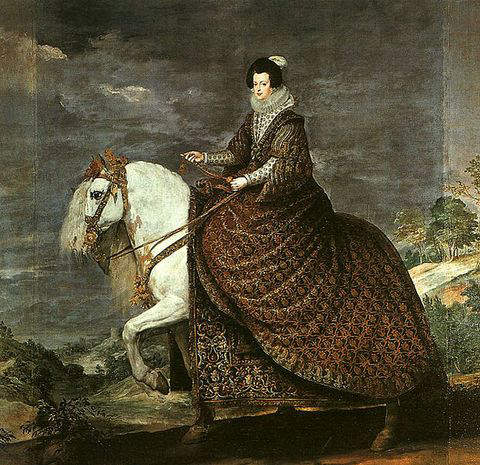
Equestrian portrait of Elizabeth of France by Diego Velazquez in 1632
Ornaments worn -
Elaborate pearl-encrusted dress.
Stomacher with drop-shaped pearl suspended as pendant.
Pearls suspended from underneath the hairdo.
Carpet encrusted with pearls.
Portrait by - Diego Velazquez in 1632
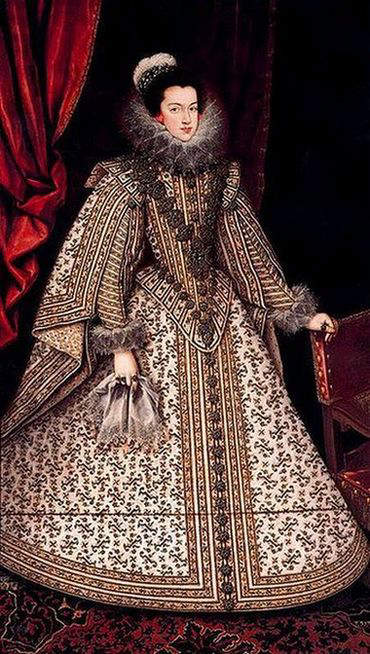
Portrait of Elizabeth of France by Villandrando executed between 1615 and 1622
Ornaments worn -
Hair ornament set with pearls.
Rows of brooches encrusted with colored stones and pearls.
Portrait by - Villandrando between 1615 and 1622.
Mariana of Austria - Second wife (1649-1665) and Queen Consort of Philip IV, King of Spain and Portugal
Elizabeth, the Queen consort died in 1644 at the age of 41 years. Two years later her only surviving son Balthasar Charles, the heir to the Spanish throne also died, at the age of 16. The double tragedy deeply shocked King Philip IV, who deprived of a legitimate heir, remarried in 1646. Philip IV took as his second wife Maria Anna, also known as Mariana of Austria, the granddaughter of Holy Roman Emperor Ferdinand II, and the daughter of King Ferdinand III of Hungary and Maria Anna of Spain, the sister of Philip IV. Thus, Mariana was Philip IV's own neice. Their marriage produced five children, out of whom only two survived into adulthood, Margaret Theresa who married her maternal uncle Leopold I, the Holy Roman Emperor and Charles, who was born mentally and physically disabled, and yet succeeded his father as King Charles II of Spain in 1665.
King Philip IV commissioned his court painter, Diego Velazquez to execute an official portrait of his second wife, Mariana of Austria, which he duly accepted and the portrait was completed in 1652. This is the most famous portrait of Mariana, which hangs in the Prado Museum in Madrid today. Mariana was 19 years old at the time it was painted. The portrait shows her full length, wearing a black dress with silver braid, and adorned with jewelry such as gold necklaces and bracelets, and a large gold brooch on her close-fitting bodice. The Queen is also shown with an elaborate hairdo with a row of pearls hanging from underneath the hairdo. Her right hand apparently rests on the back of a chair, and she is seen holding a delicate lace scarf in her left hand.
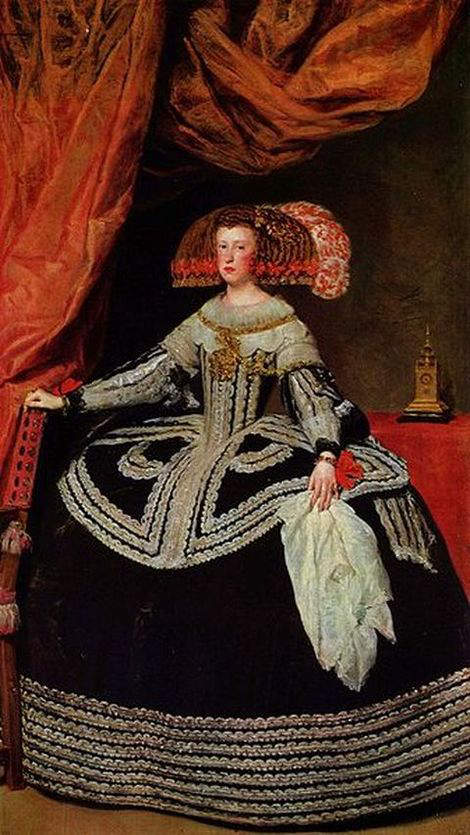
Official portrait of Mariana of Austria - Second wife and Queen consort of Philip IV, King of Spain - by Diego Velazquez
Ornaments worn -
Gold necklace and gold bracelets.
Large gold brooch fixed in front of her close-fitting bodice,
Row of pearls hanging from below the elaborate hairdo.
Hair ornament set with pearls.
Portrait by -Diego Velazquez
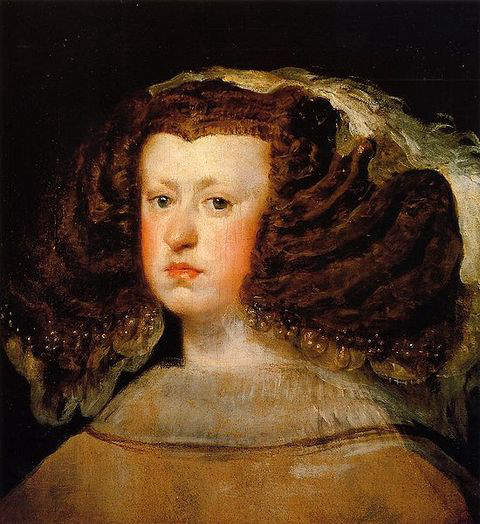
1656-Portrait of Mariana of Austria by Diego Velazquez
Ornaments worn -
Row of pearls hanging from below the elaborate hairdo.
Portrait by - Diego Velazquez
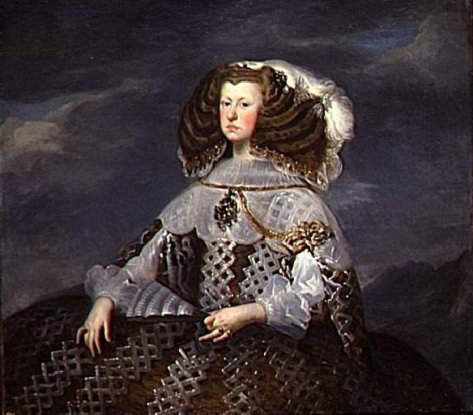
1660-Portrait of Mariana of Austria by Diego Velazquez
Ornaments worn -
Stomacher set with pearls.
Row of pearls hanging from below the elaborate hairdo.
Hair ornament set with pearls.
Shoulder brooch made of gold.
Portrait by - Diego Velazquez
Marie Louise d'Orleans - First wife (1679-1689) and Queen Consort of Charles II, King of Spain
Philip IV died in 1665 and was succeeded by his only surviving son, Charles II, who was just 3 years old, with his mother Mariana serving as his regent. Charles was both physically and mentally disabled, a result of the continuous in-breeding within the royal families of Spain, Austria and Bavaria, that led to the manifestation of undesirable recessive genes. Among his disabilities were, difficulty in chewing, speech difficulties caused by a large tongue and frequent drooling. He learnt to speak only when he was around four years old, and could not walk until he was eight. Thus, Charles was taken care of like an infant until he was 10 years old. Charles was not forced to attend school and any education he received was within the precincts of the palace. In 1675, Charles reached the required age to rule on his own, but due to his mental and physical disabilities, for most of Charles' reign, his mother Mariana acted as regent, save for a short period from 1677 to 1679, when John of Austria the Younger, an illegitimate son of Philip IV, and Charles' half-brother took control of the regency and drove Mariana out of Madrid, to return only after John's death in 1679.
In 1679, Charles II who was 18 years old married the 16-year old Marie Louise d'Orleans, the eldest daughter of Philippe I, Duke of Orleans and his first wife, Princess Henrietta of England. Charles II was deeply in love with his young and beautiful wife, but the marriage did not produce any children. Marie Louise became deeply depressed and died at 26, ten years after their marriage, leaving 28-year old Charles devastated.
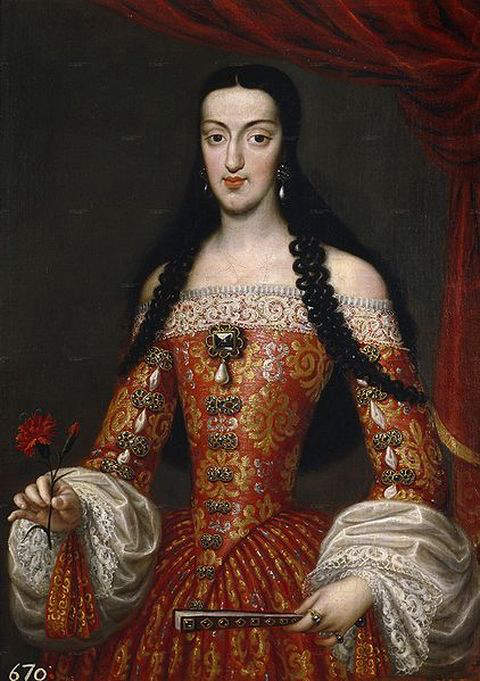
Marie Louise d'Orleans - First wife and Queen consort of King Charles II of Spain
Ornaments worn -
Pearl drop-earrings.
Stomacher with large drop-shaped pearl.
Rows of brooches along the midline of the dress and the sleeves, set with pearls and colored stones.
Portrait by - Jose Garcia Hidalgo in 1679
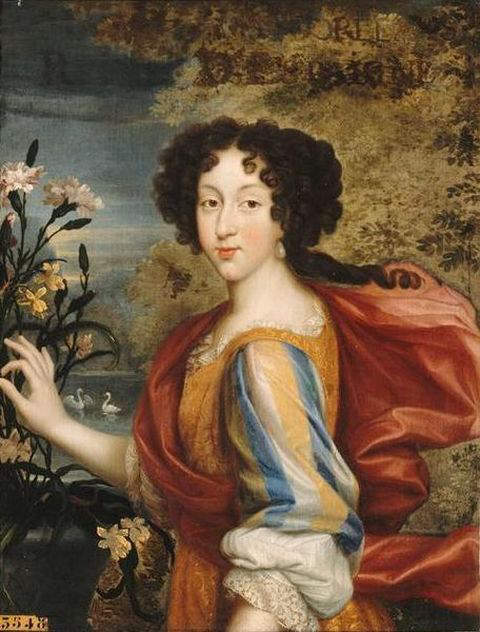
Portrait of young Marie Louise d'Orleans, eldest daughter of Duke Philip I of Orleans and his first wife Henrietta Anne of England
Ornaments worn-
Pearl drop-earrings only
Portrait by - Unknown artist
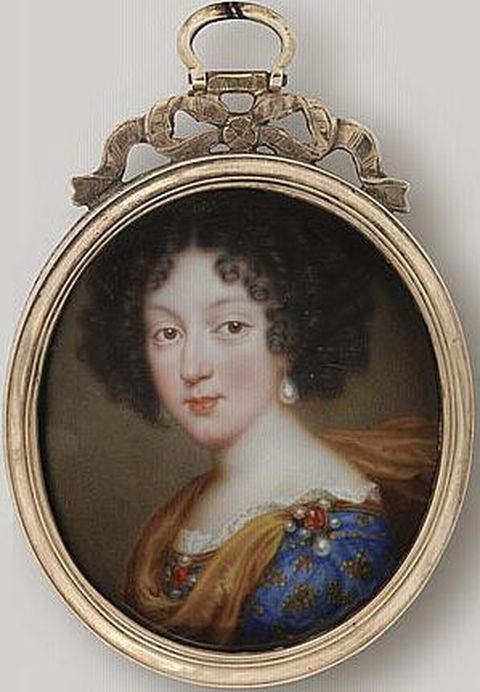
Miniature of Marie Louise d'Orleans, the future Queen of Spain, by Jean Petitot le vieux, painted in 1678
Ornaments worn -
Pearl drop-earrings.
Shoulder brooch set with colored stones and pearls.
Another brooch in front with colored stones and pearls.
Artist - Jean Petitot le vieux
Maria Anna of the Palatinate-Neuburg - Second wife (1689-1700) and Queen Consort of Charles II, King of Spain
Charles II, still in desperate need of a male heir to continue the habsburg line of succession in Spain, was compelled to take a second wife. This time he married a German princess, the 23-year old Maria Anna of Neuburg, a daughter of Philip William, Elector of Palatinate and sister-in-law of his uncle Leopold I, Holy Roman Emperor. However, even this second marriage turned out to be disappointing and could not produce the much-desired heir.
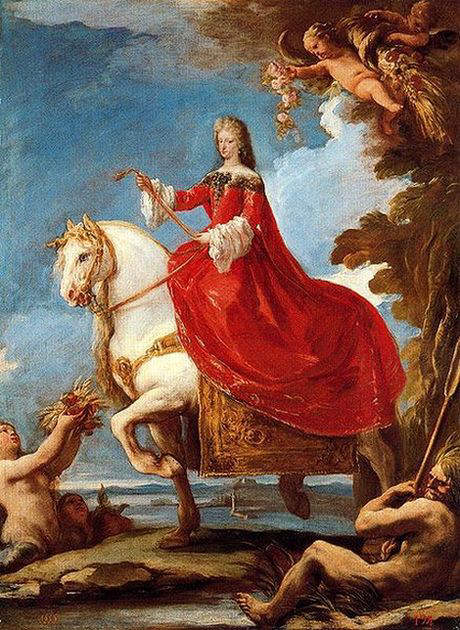
Equestrian Portrait of Maria Anna of the Palatinate-Neuburg
Ornaments worn -
Pearl drop-earrings.
Stomacher set with pearls.
Portrait by - Luca Giordano, around 1693-1694

Maria Anna of Palatinate Neuburg - Second wife of Charles II
Ornaments worn -
Single-strand pearl choker
Single row of pearls alomg the neckline of the dress.
Stomacher set with pearls.
Portrait by - Humer
Appreciation of pearls by the spouses of the monarchs of Spain from the House of Bourbon (1700-1808)
Charles II despite all his physical and mental disabilities lived for 39 years, dying in Madrid in the year 1700. His birth, despite his abnormalities was greeted with joy by the Spanish people, who always feared the consequences of a disputed succession that would perhaps lead to war, disrupting their peaceful way of life and resulting in severe hardships for the people. However, the birth of Charles only suspended temporarily any disputed succession. With the death of Charles the Habsburg line of succession in Spain also died with him. Charles himself had named his grand-nephew, Philip, Duke of Anjou - a grandson of the reigning French king Louis XIV and of his half-sister, Maria Theresa of Spain - as his successor. However, the prospect of the vast Spanish empire coming under the control of Louis XIV, if his grandson succeeded to the Spanish throne, led to a massive coalition of powers, such as the English, Dutch, Austrian and others, to oppose the Duc d'Anjou's succession. Following a treaty signed with Spain, Louis occupied several towns in the Spanish Netherlands, heightening the fears and suspicions of the coalition. This action of Louis XIV, almost immediately ignited the War of the Spanish Succession, that raged for 11 years from 1702 to 1713, engulfing almost the entire world in a bloody confrontation, fought on four continents and three oceans. At the end of the war, following the treaties of Utrecht and Rastatt, the Duc d'Anjou, Philip V was confirmed as King of Spain, almost on the same terms that the powers of Europe had agreed to before the war. Thus, the 11 years of bloodshed was in vain, achieving only little more than diplomacy might have peacefully achieved in 1701. An imporant provision of the peace treaty was that which perpetually forbid the union of the Spanish and French thrones. Philip V thus became the first ruler of the House of Bourbon to occupy the Spanish throne.
Maria Luisa of Savoy - First wife (1701-1714) and Queen consort of Philip V, Petit fils de France, Duke of Anjou and first Bourbon king of Spain
Philip V was the first Bourbon king of Spain, whose acccession to the throne of Spain in 1700, after the death of Charles II, the last Habsburg monarch of Spain who died childless, was confirmed by the Treaty of Utrecht signed in 1713, that ended the War of Spanish Succession. The Spanish empire in Europe was greatly reduced in extent, as a result of the war, that forced Spain to cede Minorca and Gibraltar to Great Britain; the Spanish Netherlands, Naples, Milan and Sardinia to the Austrian Habsburgs; and Sicily and parts of Milan to Savoy. During Philip V's rule of 45 years (save for an interruption of 7 months), the longest in modern Spanish history, he sought to reverse the decline of Spanish power and to regain lost territories in the War of Succession, in which he was only partially succcessful, but successfully defended the Spanish American territories from a large British invasion during the War of Jenkins' Ear.
Philip V married his double-second cousin Princess Maria Luisa Gabriella of Savoy the third daughter and second surviving child of Victor Amadeus II, Duke of Savoy and his wife Anne Marie d'Orleans, in November 1701. The match was arranged by Philip V's grandfather, King Louis XIV, in order to cement the Treaty of Turin, which ended Franco-Savoyard conflicts during the Nine Year's War, and had received the blessings of Philip V's brother, Louis, the Duke of Burgundy who had married Maria Luisa's elder sister, Maria Adelaide several years earlier in 1697. Maria Luisa was 13 and Philip V 18 years of age at the time of their marriage. The new Queen of Spain who was a bright and pretty girl became very popular among her subjects. She was deeply in love with her husband and acted as regent for him on several occasions during his absence from Spain at the time of the War of Spanish succession. Her most successful term as regent came in 1702, when Philip V was away fighting in Naples for nine months. Despite her young age, she gave effective leadership to the country, implementing various changes in government and mobilizing the entire country to contribute towards the war effort, and earning the respect and admiration of the people of Spain. Her adoring subjects gave her the nickname "La Savoyana." Maria Luisa gave birth to her first child, a son infant Luis Felipe in 1707, and subsequently to three more children, out of whom only two, both sons, survived into adulthood and succeded their father as Louis I and Ferdinand VI of Spain. The young and popular Queen however, came down with tuberculosis and died from its effects on February 14, 1714, devastating the entire nation and her husband Philip V.
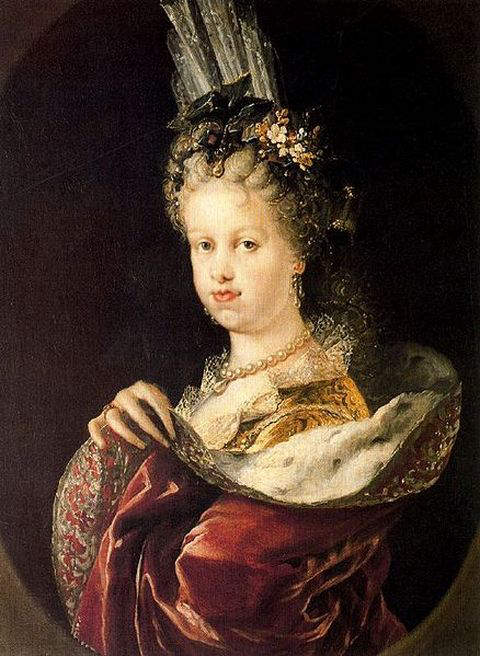
Maria Luisa of Savoy - First wife and Queen consort of Philip V
Ornaments worn -
Single-strand pearl necklace with large spherical pearls and a single drop-shaped pearl as centerpiece.
Drop-earrings with three drop-shaped pearls in each earring.
Pearl hairband with a drop-shaped pearl in the center just above the forehead.
Hair ornament.
Portrait by - Miguel Melendez in 1712
Elizabeth Farnese - Second wife (1714-1746) and Queen consort of Philip V, the first Bourbon king of Spain
Ten months after Maria Luisa died, Philip V took his second wife Elizabeth Farnese, the only child and heiress of the Duke of Pharma, Odorado Farnese and his wife Dorothea Sophie of Neuburg. Elizabeth was 21 at the time of her marriage to Philip V who was 31. Elizabeth was a very ambitious Queen, who was able to exert complete influence over Philip V and his policies. It was under her influence that Philip I pursued vigorously the policy of trying to recover the ancient Italian possessions of Spain that led to confrontation with the triple alliance and the abandonment of this policy. In January 1724, Philip V abdicated his throne, in spite of Elizabeth Farnese's advice to the contrary, to his eldest son from his first marriage, the seventeen year old Louis, the Prince of Asturias who ascended the throne as king Louis I of Spain. Historians do not seem to agree on the causes of Philip V's voluntary abdication in favor of his son, but the possible reasons attributed vary from mental instability and decline to Philip V's desire to inherit the French throne after Louis XIV, which was not possible had he continued as King of Spain, as the Treaty of Utrecht prohibited the union of the French and Spanish Crowns. Whatever might have been the cause of this abdication, King Louis I of Spain died unexpectedly of smallpox, in August of 1724, just 7 months after ascending the throne, forcing the return of Philip V to the Spanish throne, as the next in line of succession to the throne, his second son from his first marriage was still a minor. Thus Philip V's reign continued from September 1724, after the short interruption of 7 months, and ended only after his death in 1746, having ruled Spain for 45 years, the longest in modern Spanish history.
During the latter part of his rule, Philip V's mental instability worsened and he suffered from frequent bouts of depression, that was relieved to some extent by the singer Farinelli and his musicians who played for the benefit of the king and queen every night. During this period Queen Elizabeth Farnese completely dominated her husband and ruled Spain on his behalf directing the destinies of the nation. Elizabeth Farnese had seven children by her marriage to Philip V, out of whom six, three sons and three daughters, survived into adulthood. Her eldest son, Charles III succeeded her stepson Ferdinand VI as King of Spain in 1759, during her lifetime. Elizabeth survived her husband by twenty years and died in 1766.

Official portrait of Elizabeth Farnese, Queen consort of Philip V, by Louis-Michel van Loo in 1739
Ornaments worn -
Single-strand pearl hairband.
Pearl hair ornament.
Drop-earrings with single drop-shaped pearl in each earring.
Stomacher set with colored stones and pearls and three large drop-shaped pearls suspended from it.
Multistrand pearl bracelet on the left hand.
A crown studded with pearls is also depicted on one side of the portrait.
Portrait by - Louis-Michel van Loo in 1739
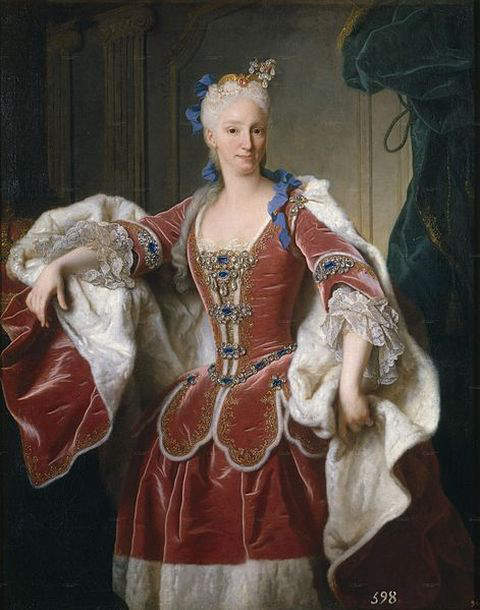
Portrait of Elizabeth Farnese - Queen of Spain by Jean Ranc
Ornaments worn -
Hair ornament with drop-shaped pearls.Single-strand of pearls decorating the Queen's hair on the right side.
Stomacher set with blue sapphires and pearls, with drop-shaped pearls suspended from it.
Brooches below the stomacher, on the sleeves and shoulder, also set with blue sapphires and pearls.
Belt made of blue sapphires and pearls.
Portrait by - Jean Ranc

Philip V of Spain and his Queen consort Elizabeth Farnese in 1743
Ornaments worn by the Queen-
Hair ornament with pearls
Hair band with pearls.
Pearl drop-earrings.
Elaborate stomacher with colored stones and pearls and three drop-shaped pearls suspended from it.
Multistrand pearl bracelets on both hands.
Pearl-studded crown on the cushion by the Queen's left hand side.
Portrait by - Louis-Michel van Loo in 1743
Louise Elizabeth d'Orleans - Wife and Queen consort of Louis I, King of Spain from January 14, 1724 to August 31, 1724
Louis I was the king of Spain for one of the shortest periods in its history, from January 14, 1724 to August 31, 1724, just over 7 months. He ascended the throne after his father, King Philip V voluntarily abdicated in his favor on January 14, 1724. He was the eldest son of Philip V by his first wife Maria Luisa of Savoy, who died in 1714, and thus became Prince of Asturias and heir apparent to his father's throne. Louis was seven years of age at the time his mother died. In January 1722 at the age of 15 years, encouraged by his father Philip V, Louis met and married 13-year old Louise Elizabeth d'Orleans, a daughter of Philip II, Duke of Orleans, the regent for king Louis XV of France and his wife, Francoise Marie de Bourbon. The dowry of this marriage was an enormous 4 million livres. Elizabeth became the Princess of Asturias after her marriage to Louis. However, Elizabeth could not adjust herself to court life in Spain, partly due to the poor education she received as a child. Unable to cope with the pressures of court life, she showed odd behaviour, and would often refuse to speak even to her husband. The marriage did not produce any children. Elizabeth became the Queen of Spain when her husband ascended the throne of Spain as King Louis I, on January 14, 1724 after the voluntary abdication of his father. However, her reign as Queen was short lived as her husband Louis I died of smallpox, on August 31, 1724. Soon after Louis' death, Philip V once again ascended the throne of Spain, and the widowed Elizabeth returned to her mother in France, the Dowager Duchess of Orleans.

Louise Elizabeth d'Orleans - Wife and Queen consort of Louis I, King of Spain for just over 7 months
Ornaments worn -
Pearl hair ornament with drop-shaped pearl in the center.
Stomacher with drop-shaped pearls hanging from below.
Pearl brooches on the sleeves and shoulder.
Portrait by - Jean Ranc in 1724
Maria Barbara of Braganza / Barbara of Portugal - Wife and Queen consort of Ferdinand VI, King of Spain from 1746 to 1759
After Philip V died on July 9, 1746, he was succeeded by Ferdinand VI, his second surviving son by his first wife Maria Luisa of Savoy. Ferdinand was the third king of the Spanish Bourbon dynasty. Ferdinand who was born in 1713, was 33 years of age at the time he ascended the throne. In 1729, at the age of 16 years he married Infanta Barbara of Portugal who was two years his senior, and the eldest child and daughter of King John V of Portugal and his wife Archduchess Maria Anna of Austria. This was part of a double-marriage between the royal families of Spain and Portugal. At the same time Ferdinand's half-sister, the Spanish Infanta Mariana Victoria married Infanta Barbara's brother Joseph, heir to the throne of Portugal.
In 1746, when Ferdinand VI ascended the throne of Spain, Barbara became the Queen of Spain. The marriage of Ferdinand and Barbara turned out to be a very successful one, even though it did not produce any issues. The couple were totally devoted to one another. Ferdinand became deeply attached to his wife and shared her passion for music. Barbara herself was an accomplished keyboard player, having been a student of Domencio Scarlatti, the famous harpsichordist and composer, who followed her to Madrid after Barbara's marriage to Ferdinand, and composed hundreds of harpsichord sonatas while serving in the court at Madrid. The death of Barbara in August 1758 totally devasted Ferdinand VI and broke his heart, a condition from which he never recovered, and Ferdinand too died an year later in August 1759.

Barbara of Portugal - Wife and Queen consort of Ferdinand VI, King of Spain
Ornaments worn -
The above portrait of Barbara of Portugal was probably executed by artist Domencio Dupra, long before her husband Ferdinand ascended the throne as king of Spain in 1746. Barbara married Ferdinand, two years her junior at the age of 18 in 1729. The youthful look of the princess in the portrait shows that it was executed not long after her marriage in 1729. Although a beauty in her youth, in her later life she was known to have become quite overweight.
The most striking feature of this portrait is the simplicity in the mode of dressing of the princess, almost devoid of any jewelry or ornaments except for a hair ornament set with colored stones and pearls.
Portrait by - Domencio Dupra
Maria Amalia of Saxony - Wife and Queen consort of Charles III, king of Spain from 1759 to 1788 and king of Naples and Sicily from 1734-1759
When Ferdinand six died in 1759 without issue he was succeeded by his half-brother and Philip V's eldest son by his second wife Elizabeth Farnese, Charles, who ascended the throne as Charles III and became the 4th-king of the Spanish Bourbon dynasty. At the time of his birth in 1716, Infante Charles was 4th in line of succession to the Spanish throne after his three elder half-brothers, Infante Luis, Prince of Asturias, who ruled briefly as Louis I of Spain before his death in August 31, 1724; Infante Felipe, who died in 1719 at the age of seven years; and Ferdinand, who succeeded Philip V in 1746. As his two elder half-brothers who ruled Spain, died without any issue, it was the turn of Charles to ascend the throne as king of Spain.
However, before ascending the throne of Spain Charles had already been crowned as the King of Naples and Sicily in 1735, former Italian possessions of Spain ceded to Austria under the Treaty of Utrecht, that concluded the War of the Spanish Succession, but captured by Charles, the Duke of Parma in 1734. Charles had previously inherited the Duchy of Parma in 1731, after the death of his childless great uncle Antonio Farnese, Duke of Parma. Charles made peace with Austria in 1735, which was finalised in 1738 by the Treaty of Vienna, under which the kingdoms of Naples and Sicily were ceded by Austria to Charles, who ceded the Duchy of Parma to Austria and gave up his claims to the throne of Tuscany in favor of Francis Stephen. The treaty also allowed the transfer to Naples of all inherited movable property such as collection of artworks, the archives, the ducal library, the canons of the fort etc. Charles entered the War of Austrian succession on the side of Spain, France and Prussia in 1744, after initially remaining neutral due to constraints placed by the peace treaties signed with Austria in 1738 and 1740 and the threat of British bombardment of Naples if Charles did not stay out of the conflict. In the Battle of Velletri that followed in August 1744, the troops of Naples and Sicily and Spanish troops commanded by Charles, defeated the Austrian army led by the Prince of Lobkowitz who withdrew with heavy losses. At the end of the war Charles was given back the Duchy of Parma, which he handed over to his younger brother Infante Felipe, who became the Duke of Parma.
Charles was the most popular king of Naples and Sicily, sensitive to the needs of the people, and taking steps to develop the economy of his kingdom, such as the creation of the "commerce council" that negotiated trade with the Ottomans, French, Dutch and Swedes; exploiting the natural resources of the country; founding of an insurance company; building of the Capodimonte porcelain factory and taking measures to protect the forests. He also introduced administrative, social and religious reforms in his country. He was also a prolific builder, builing palaces such as the Palace of Caserta, one of Europe's most lavish palaces, the Palace of Portici, the Palace of Capodimonte, and the Teatro di San Carlo, built in just 270 days. Charles is also credited with the founding of the Ercolanesi Academy and the Naples National Archaeological Museum. Charles encouraged archaeological excavations during his rule that led to the re-discovery of the ancient Roman cities of Herculaneum, Stabiae and Pompeii.
In 1738, Charles married a German princess, Maria Amalia of Saxony, the daughter of Augustus III of Poland, Elector of Saxony and Maria Josepha of Austria. Maria Amalia was 14 and Charles 22 at the time of their marriage. Their marriage turned out to be a very successful one producing 13 children of whom eight survived into adulthood. By virtue of her marriage to Charles, the king of Naples and Sicily, Maria Amalia became the Queen consort of Naples and Sicily, a position which she held for 21 years from 1738 to 1759, until King Charles ascended the throne of Spain in 1759 as Charles III of Spain, abdicating the throne of Naples and Sicily in favor of Ferdinand, his third surviving son who became Ferdinand I of the Two Sicilies. Maria Amalia was an educated and cultured woman, who played an important role in the planning of the construction of palaces and the Capodimonte porcelain factory by her husband. She was also a patron of the composer Gian Francesco Fortunati, who was a favorite at the court of Naples.
When Ferdinand VI of Spain died on August 10, 1759, Charles was proclaimed the king of Spain with the title Charles III of Spain. After Charles abdicated the throne of Naples and Sicily in favor of his third surviving son Ferdinand on October 6, 1759, he and his wife Maria Amalia left Naples for Spain, arriving in Barcelona on October 7, 1759. Maria Amalia now became the Queen consort of Spain. Both Charles III and Maria Amalia who had gathered enough experience as the king and queen of Naples and Sicily had no problem fitting into their new role as the king and queen of Spain. Charles applied the same principles of "enlightened absolutism" which he introduced in Naples and Sicily in ruling his new domains, that allowed religious toleration, freedom of speech and the press, and the right to hold private property, while encouraging education, the arts and the sciences. Charles III shared these ideals with other monarchs of his period, such as Maria Theresa of Austria, and Catherine the Great of Russia. Charles III's achievements in Spain included rapid economic development, liberalisation of trade and commerce, building of roads, canals and drainage works, building of the luxury porcelain factory assisted by his wife Queen Maria Amalia, rapid industrialization of the areas of Catalonia and Asturias, modernization of other cities in Spain apart from the capital city Madrid, construction of the famous Puerta de Alcala in Madrid, building of the National Art Museeum, and the Museo del Prado, reorganizatiom of the Spanish army and navy, and introducing domestic political reforms. Charles III may also be referred to as the Father of modern Spain, who gave the country a national identity, creating a national anthem and a national flag, and building a modern capital city with a network of roads converging on it.
The greatest tragedy that Charles had to deal with at the beginning of his rule in Spain was the death of his beloved wife Maria Amalia who died of tuberculosis on September 27, 1760 at the age of 35 years. Charles did not re-marry until his death 28 years later on December 14, 1788.
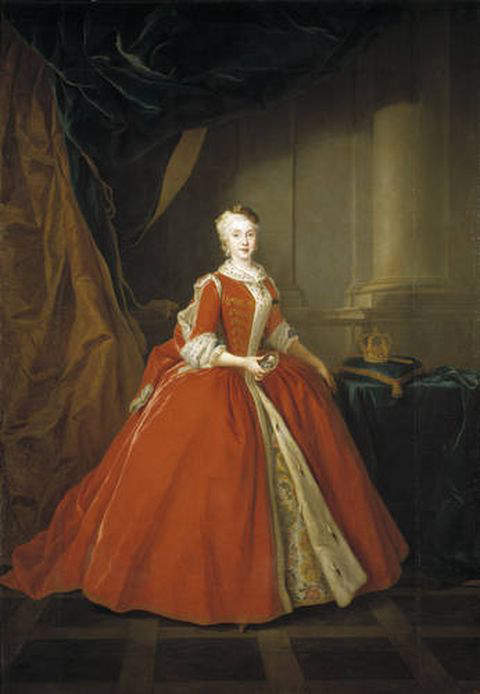
Maria Amalia of Saxony in 1738 - Queen consort of Naples and Sicily from 1738-1759
Ornaments worn -
Hair ornament
Drop-earrings
A necklace
Details of the ornaments, such as gemstones used are not clear due to the distance at which the portrait had been drawn. The queen is wearing a Polish red jupeczka.
Portrait by - Louis de Silvestre in 1738
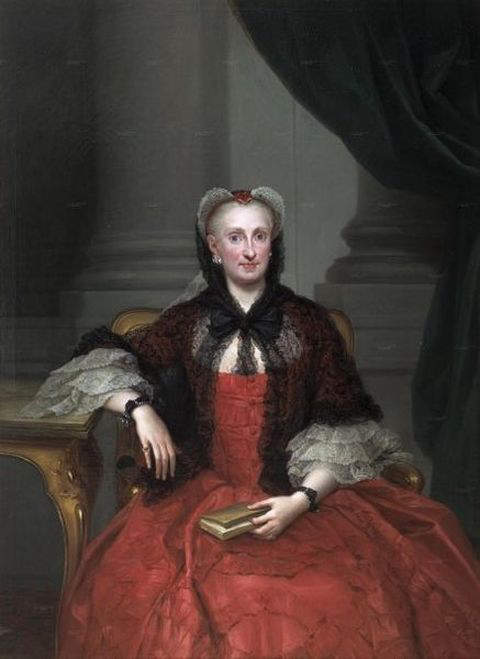
Maria Amalia of Saxony - Queen consort of Spain from 1759-1760
Ornaments worn -
Drop-earrings set with pearls.
Bracelets - details not clear.
Hair ornament - details not clear.
Portrait by - Anton Raphael Mengs after 1758.
Maria Louisa of Parma - Wife and Queen consort of Charles IV, king of Spain from 1788 to 1808
When Charles III died on December 14, 1788, he was succeeded by his second surviving son, Charles, the Prince of Asturias, who ascended the throne of Spain as Charles IV. Charles III's eldest son Don Felipe was left out of the succession as he was mentally retarded and epileptic. His third surviving son, Ferdinand, ascended the throne of Naples and Sicily in 1759, when Charles III abdicated this throne in his favor, enabling the latter to ascend the throne of Spain, when his elder half-brother Ferdinand VI died on August 10, 1759, without issue. Charles IV was born in 1748 at Portici in the kingdom of Naples and Sicily, when his father Charles III was the reigning monarch of the kingdom.
In 1765, Charles, the Prince of Asturias married his first cousin, Maria Louisa, the daughter of Philip, Duke of Parma, the younger brother of Charles III. Charles was 17 and Maria Louisa 14 years of age at the time of their marriage. As there was no Queen in Spain at the time of their marriage, Queen Maria Amalia wife of Charles III having died in 1760, Maria Louisa, the Princess of Asturias, assumed the role of the first lady of the Spanish court, soon after her marriage to the Prince of Asturias. Maria Luisa was pretty during her youthful years, but her beauty seem to have faded with age, particularly after her 14 childbirths, that led her to make conscious efforts to dress elegantly and look pretty, as her later portrits reveal. At the time Maria Luisa became the Queen consort of Spain in 1788, she was 37 years old and had already given birth to 10 children.
Maria Luisa turned out to become a very powerful queen in Spanish history as her husband Charles IV, though a powerful monarch left most of the affairs of his government to his wife and his prime minister, the king occupying himself mostly with his favorite pastime hunting. Maria Luisa worked with three prime ministers of Spain; first with the Count of Floridablanca, whom she replaced in 1792 with the Count of Aranda, who was in turn replaced by her favorite, Manuel de Godoy, when France declared war on Spain, following Spanish protests against the execution of the deposed king Louis XVI in 1793, during the French revolution. In 1795, Godoy was forced to conclude an alliance with France and declare war on the United Kingdom. Spain remained an ally of France and even supported the continental blockade, until the British naval victory at Trafalgar, when it took a pro-British stand. However, after Napoleon's victory over Prussia in 1807, Godoy under the influence of Maria Luisa and Charles IV, again steered Spain back onto the French side, that increased the unpopularity of not only the king and queen but also the prime minister Godoy. The frequent change in allegiance of the Spanish during this tumultous period in the history of Europe, also devalued king Charles IV's position as a trustworthy ally, and strengthened the support for Crown Prince Ferdinand, who favored close co-operation with the United Kingdom.
Things came to a head in 1808, when the population rose against Charles IV and his prime minister Godoy at Aranjuez, when the king took the side of Godoy after Crown Prince Ferdinand appealed to Napoleon against the minister. King Charles IV was forced to abdicate his throne in favor of his son Ferdinand on March 19, 1808, in order to save the life of his prime minister who had been taken captive. Crown Prince Ferdinand then ascended the throne of Spain as Ferdinand VII and turned to Napoleon for support, who had already a 100,000 soldiers in Spain by that time. However, Napoleon, who had his own plans for Spain, summoned both Charles IV, who had taken refuge in France with Maria Luisa and Godoy, and Ferdinand VII to Bayonne in April,1808, and under the pretext of acting as mediator between father and son, coaxed Charles IV to retract his earlier abdication, and again abdicate in his favor on May 5, 1808. Napoleon then forced Ferdinand VII to abdicate on May 6, 1808, in his favor. Thus, both claimants to the Spanish throne having abdicated in Napoleon's favor, he chose his elder brother Joseph Bonaparte as the new monarch of Spain.
Charles IV, Maria Luisa and Godoy spent the rest of their lives in exile in France and Italy. Charles IV was given a pension by Emperor Napoleon, and he and his wife lived in France until 1812, after which they settled in Rome in the Palazzo Barberini. Maria Luisa died on January 2, 1819, and soon afterwards on January 20, 1819, Charles IV also died, probably due to overwhelming despair and heartbreak caused by the death of his beloved wife.

Maria Louisa of Parma in 1765- Princess of Asturias, wife of Charles, Prince of Asturias, future Charles IV, King of Spain
Ornaments worn -
Pendant earrings set with pearls.
Choker necklace set with pearls and colored stones and a large drop-shaped pearl suspended from it.
Multistrand pearl bracelets on both hands.
Brooch set with colored stones and pearls.
Hair ornament set with pearls.
Portrait by - Anton Raphael Mengs in 1765

Maria Louisa of Parma in 1765 at the age of 14
Portrait by Anton Raphael Mengs in 1765 of the youthful princess Maria Louis of Parma. The striking feature of this portrait is the depiction of the youthful princess without any ornaments.
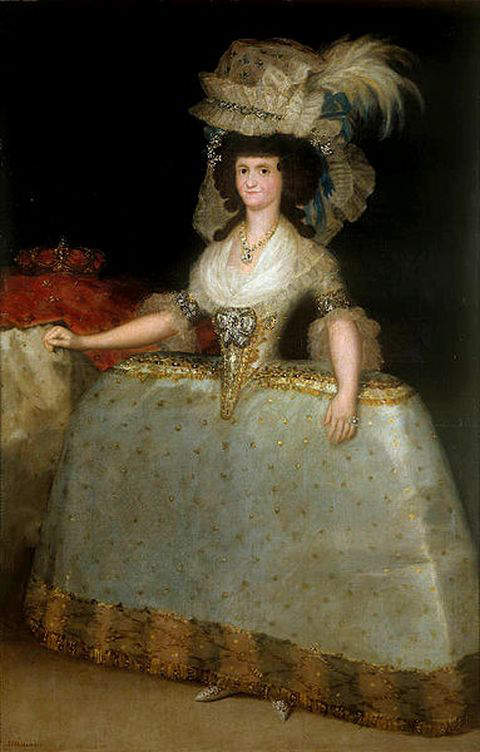
Maria Louisa of Parma, wearing panniers as Queen of Spain in 1789
Ornaments worn -
Necklace set with pearls and colored stones.
Hair ornaments set with pearls.
Ornaments on headdress set with pearls and colored stones.
Large stomacher set with pearls and colored stones.
Arm bands set with pearls and colored stones.
Elaborate dress with panniers embroidered with pearls.
Cluster ring set with pearls.
Portrait by - Francisco de Goya in 1789
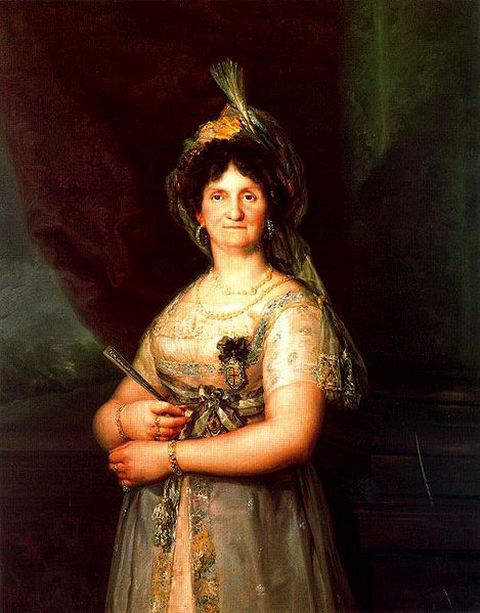
Portrait of Maria Louisa of Parma executed in 1819, based on an original by Goya in 1816
Ornaments worn -
Large bangle-like earrings set with pearls.
Two pearl necklaces of different lengths.
Brooch set with colored stones.
Bracelets set with colored stones.
Portrait by - Vincent Lopez Portana in 1819, based on an original by Francisco de Goya in 1816
Maria Antonia of Naples and Sicily - Princess of Asturias, first wife (1802-1806) of Ferdinand, Prince of Asturias, future Ferdinand VII of Spain
Ferdinand was the eldest son of Charles IV and his wife Maria Luisa of Parma. Born in 1784, Ferdinand became the Prince of Asturias and heir to the Spanish throne, when his father, Charles IV ascended the throne of Spain in December 1788. In 1802, Ferdinand married his first cousin Princess Maria Antonia of Naples and Sicily, the youngest daughter of Ferdinand I of the Two Sicilies (younger brother of Charles IV) and Maria Carolina of Austria (sister of Marie Antoinette, Queen of France, executed during the French revolution). Ferdinand who was 18 at the time of his marriage was just two months elder to his wife, Maria Antonia. The Princess of Asturias was an intelligent girl, having learnt several languages by the age of seventeen. She resented the extraordinary powers wielded by her mother-in-law, Queen Maria Luisa and her favorite and alleged lover Manuel Godoy, excluding her husband the heir apparent from a share in the government. At the instigation of Maria Antonia, Ferdinand resorted to various intrigues against Maria Luisa and Godoy, who were becoming increasingly unpopular in the country. National discontent generated by a weak government led to a revolution in 1805.
Maria Antonia's marriage to Prince Ferdinand led to two pregnancies in 1804 and 1805, but both of them ended in miscarriages. The princess' health began to fail as she contracted tuberculosis, and she died on May 21, 1806, at the Royal Palace of Aranjuez in Spain.
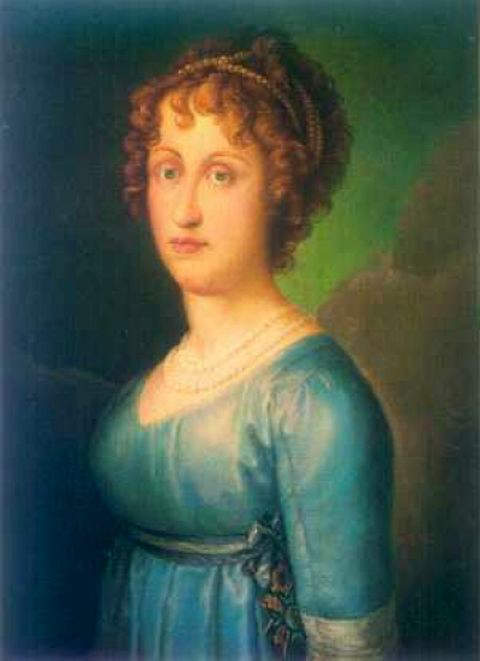
Maria Antonia of Naples and Sicily - Princess of Asturias, first wife of Ferdinand, Prince of Asturias (future Ferdinand VII of Spain)
Ornaments worn -
Two single-strand pearl necklaces of different lengths.
Long single-strand of pearls used as head band.
Portrait by - Vincent Lopez Portana between 1805 to 1806
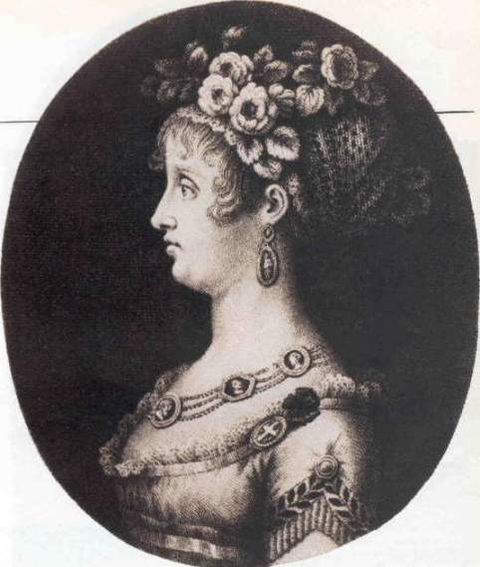
Portrait of Maria Antonia of Naples and Sicily, Princess of Asturias, by unknown artist
Ornaments worn -
Necklace incorporating cameos surrounded by pearls and connected by three strands of pearls.
Drop-earrings incorporating oval-shaped cameo.
Head band incorporating flower ornament.
Shoulder brooch incorporating a cameo depicting a cross, surrounded by a row of pearls.
Portrait by - Unknown artist
Maria Isabel of Portugal - Second wife (1816-1818) and Queen consort of Ferdinand VII, King of Spain in 1808 and again from 1813-1833
After the death of Maria Antonia, Prince Ferdinand continued his opposition to the rule of Maria Luisa and Godoy, and became the nucleus of a popular opposition against the government. In 1807, Prince Ferdinand was arrested for his complicity with liberal reformers in seeking the help of Emperor Napoleon against the government. Popular riots broke out at Aranjuez in March 1808, and prime minister Manuel Godoy was taken hostage. King Charles IV was then forced to abdicate his throne in favor of his son and crown prince Ferdinand on March 19, 1808 in exchange for the safe release of his prime minister Godoy. Charles IV, his wife Maria Luisa and his prime minister Godoy, then sought refuge in France, where they were granted asylum. Crown prince Ferdinand who ascended the throne as Ferdinand VII, then turned to Napoleon for support. However, Napoleon who already had 100,000 soldiers in Spain, had his own plans, and inviting both father and son to Bayonne under the pretext of mediating between the two, extracted abdications from both of them in his favor, and appointed his elder brother, Joseph Bonaparte as the new monarch of Spain. Ferdinand VII was then interned in the Chateau of Valencay in France for the next six years, under tight security.
Ferdinand VII's abdication and Napoleon's choice of Joseph Bonaparte as the new monarch was acknowledged by the government, but vehemently opposed by the people of Spain, who rose against the government. Provincial juntas were established and a campaign of resistance began against the French occupation.The Battle of Bailen proved that the Spanish could effectively resist the French. Soon after this the Council of Castile that had previously acknowledged the new monarch, revoked its decision, and declared the abdications of Bayonne null and void, on August 11, 1808. Subsequently, on August 24, the Council proclaimed Ferdinand VII as king of Spain again. The British Government acknowledged Ferdinand VII as the king of Spain on January 14, 1809. Five years later, on December 11, 1813, Napoleon Bonaparte after experiencing reverses on many fronts, agreed to acknowledge Ferdinand VII, as king of Spain, by signing the Treaty of Valencay, enabling Ferdinand VII to return to Spain. On March 24, 1814 Ferdinand VII was handed over by the French to the Spanish army at the border town of Girona, and from their began the celebratory procession marking the triumphal entry of Ferdinand VII into Madrid.
Although Ferdinand VII pomised to rule Spain under the Liberal Constitution of 1812, at the time of his re-entry, soon under the influence of the conservatives and the Church, he rejected this constitution and began to rule as an abolute monarch.
On September 29, 1816, Ferdinand VII took his second wife, after the death of his first wife Maria Antonia of Naples and Sicily, 10 years ago. His second wife was his own niece Maria Isabel of Portugal, the daughter of John VI of Portugal and his wife Carlota Joaquina, his elder sister. Queen Maria Isabel was a collector and connoisseur of art works, and soon after becoming queen embarked on a project to collect many treasures from the past as possible and create a royal museum, which became the forerunner of the Museo del Prado of Spain.
Maria Isabel's first pregnancy resulted in the birth of a daughter who survived only for four months. She was soon pregnant again, but the birth of the second child proved to be difficult, and Maria Isabel died from the complications resulting from her second confinement, on December 26, 1818.
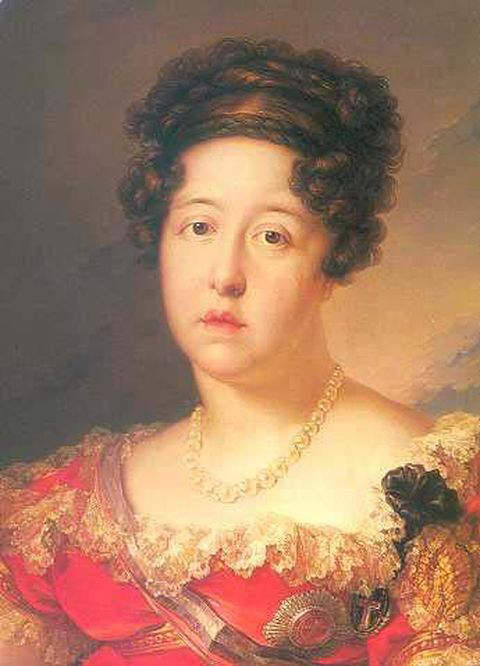
Maria Isabel of Portugal, Queen consort of Ferdinand VII, King of Spain - Portrait by Vincent Lopez between 1816-1818
Ornaments worn -
Single strand pearl necklace.
Gold brooch with colored stone in the center.
A second brooch depicting a cross.
Arm bands set with pearls.
Portrait by - Vincent Lopez Portana
Maria Josepha of Saxony - Third wife (1819-1829) and Queen consort of Ferdinand VII, king of Spain in 1808 and again from 1813-1833
Maria Isabel, Ferdinand VII's second wife died in 1818, having failed to provide her husband with an heir to the throne. Ferdinand VII was thus compelled to take a third wife in order to produce an heir, that would ensure a smooth succession after him. His third choice as queen consort was the young and beautiful Maria Josepha of Saxony, the youngest daughter of Prince Maximilian of Saxony and his first wife, Princess Caroline of Bourbon-Parma, daughter of Duke Ferdinand of Parma. They married in Madrid on October 20, 1819. Ferdinand was 35 and Maria Josepha 16 at the time of their marriage. Maria Josepha was physically more beautiful than Ferdinand VII's two previous wives, Maria Antonia and Maria Isabella. Ferdinand VII fell deeply in love with the young queen. They were married for 10 years, but unfortunately the marriage remained childless. Maria Josepha died on May 18, 1829, devastating her husband who was totally heartbroken by the loss of his beloved wife.

Maria Josepha of Saxony - Third wife and Queen consort of Ferdinand VII, king of Spain from 1813 to 1833
Ornaments worn -
Tiara set with emeralds and probably diamonds.
Necklace set with emeralds and diamonds.
Bracelet set with emeralds and diamonds.
Rings incorporating emeralds and diamonds.
Drop-earrings incorporating emeralds and diamonds.
A double-strand of pearls between the bodice and the lower part of her dress.
Portrait by - Francisco Lacoma y Fontanet between 1819 to 1829
Maria Christina of the Two Sicilies - Fourth wife (1829-1833) and Queen consort of Ferdinand VII, king of Spain in 1808 and again from 1813 to 1833
After the death of his third wife, Maria Josepha of Saxony, who also could not give him an heir, Ferdinand was forced to contract a fourth marriage in his desperation to father an heir for his crown. His fourth wife and Queen consort, was another niece of his, Maria Christina of the Two Sicilies, daughter of King Francis I of the two Sicilies and his second wife Maria Isabella of Spain, his younger sister. The marriage took place on December 11, 1829. Ferdinand was 45 and Maria Christina 23 at the time of their marriage. Ferdinand VII's 4th marriage turned out to be successful, producing two healthy issues in quick succession, one in 1830 and the other in 1832, both of whom survived into adulthood, but unfortunately both children were daughters. The succession laws of Spain permitted only males to inherit the Spanish crown. As such Maria Christina persuaded her husband to amend the law of succession of Philip V, the founder of the Spanish Bourbon dynasty, that permitted only males in the royal family to inherit the throne. Accordingly, Ferdinand VII amended the law of succession to the Spanish throne, in line with succession laws of other monarchies of Europe, such as the United Kingdom and the Austro-Hungarian empire, to allow females also to inherit the crown in the absence of a male heir.
Ferdinand VII died on September 29, 1833, and his 3-year-old eldest daughter Isabella was proclaimed Queen of Spain, as Isabella II of Spain, with her mother Maria Christina as regent to the infant Queen. However, Isabella II's succession to the throne was disputed by her uncle and Ferdinand VII's younger brother, Infante Charles, the Count of Molina, who was next in line of succession to the throne according to the previous succession laws. The dispute resulted in the Carlist Wars, with the country polarized into two factions, the supporters of Queen Isabella II and her mother and regent Maria Christina, who favored a liberal constitution and progressive social policies, and the supporters of Charles, Count of Molina, who favored a return to traditional society and an absolute monarchy; the faction that was supported by the Roman Catholic Church. However, the Spanish army's loyalty to Queen Isabella II and her Regent Maria Christina proved the decisive factor in the war, and Queen Isabella II was confirmed as the new sovereign of Spain, with Maria Christina as the regent.
Maria Christina betrayed the trust placed in her by the people and the army of Spain, when she secretly married a low-ranking soldier, a sergeant from the royal guard, Augustin Fernando Munoz, soon after the death of her husband, King Ferdinand VII. Maria Christina managed to keep her marriage to the ex-sergeant a secret for seven years, until 1840, during which period she had given birth to five children of the sergeant. When the news of Maria Christina's secret marriage to a low-ranking soldier became public, it created deep resentment among the public, and the ex-Queen and regent to Queen Isabella became so unpopular in the country, that the military and the political leadership of the country demanded that she step aside from the regency, which she did, and the army commnder, General Baldomero Espartero, Count of Luchana, replaced her as regent. Maria Christina then went into permanent exile in France, where she was subsequently joined by her daughter Queen Isabella II, who was overthrown in a revolution in 1868. She died in France in 1878 aged 72 years.
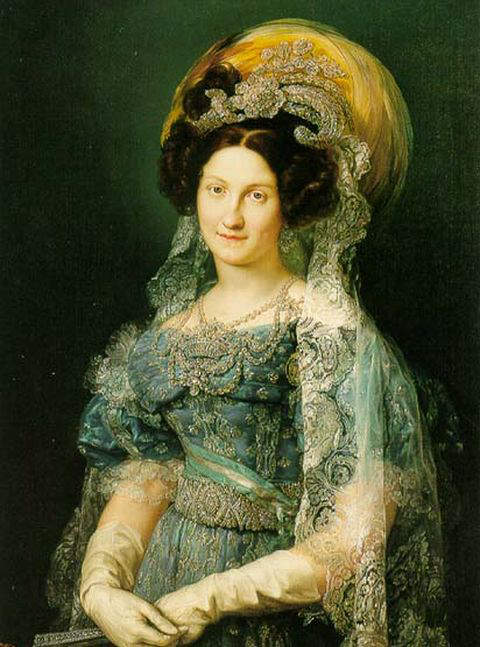
Maria Christina of the Two Sicilies - Fourth wife and Queen consort of Ferdinand VII, king of Spain in 1808 and again from 1813 to 1833
Ornaments worn -
Complicated pearl ornament combining necklace and stomacher made up of strands of pearls and possibly diamonds.
Large head ornament based on floral and scrollwork design, possibly set with diamonds.
Belt studded with diamonds.
Portrait by - Vincent Lopez Portana between 1829-1833
Julie Clary - Wife and Queen consort of Joseph Bonaparte, King of Naples and Sicily (1806-1808) and King of Spain and the Indies from 1808 to 1813
After Napoleon Bonaparte extracted abdications of the Spanish throne in his favor, from both Charles IV and his eldest son and heir, Ferdinand VII at Bayonne, he appointed his elder brother Joseph Bonaparte, who was then the King of Naples and Sicily, as the King of Spain and the Indies on June 6, 1808. Joseph Bonaparte was replaced by his brother-in-law Joachim Murat as the King of Naples and Sicily. Joseph Bonaparte reluctantly accepted his new appointment, and soon after he arrived in Spain the French army suffered a series of early defeats by the Spanish regular army, forcing him to retreat with his army to northern Spain. Napoleon then sent French regular troops and reinforcements to assist Joseph's army comprising mainly of poorly-trained levies. Joseph's army then moved southwards again and recaptured Madrid and other cities and provinces. However, during Joseph's reign of over five years, his army was never able to establish total control over the entire country, and had only nominal control over many cities and provinces. Finally after the defeat of the French forces at the Battle of Vitoria in 1813, Joseph Bonaparte abdicated the throne on December 11, 1813 and returned to France. Napoleon was now left with no alternative but to acknowledge Ferdinand VII as the King of Spain, and release him from the Chateau of Valencay, where he was incarcerated, after signing the treaty of Valencay, that also enabled his return to Spain and continue his reign as king.
Joseph Bonaparte married Julie Clary, the daughter of a wealthy silk manufacturer and merchant of Marseille, France, on August 1, 1794. In 1806, when Joseph Bonaparte was appointed King of Naples and Sicily, by Napoleon Bonaparte, she became the Queen consort of Naples and Sicily. In 1808, when Joseph Bonaparte was made the King of Spain, she became the Queen consort of Spain, but did not accompany her husband to Spain. Instead she preferred to remain in France with her two daughters. After her husband abdicated the Spanish throne in 1813, he left for the United States, where he stayed initially at New York City and Philadelphia and later moved to an estate known as Point Breeze, purchased in New Jersey. In 1840, he returned to Europe, where he joined his wife, Julie in Florence. After the downfall of Napoleon Bonaparte in 1814, Julie bought the Castle of Prangins in Switzerland, where she stayed until 1816, and later moved to Frankfurt with her daughters for the next six years. She then settled in Brussels for sometime, and finally moved to Florence, Italy, where she lived at the Serristori Palace, and joined by her husband in 1840. In spite of his previous adulterous relationships, Julie accepted her husband back into her household. Joseph Bonaparte died in her arms on July 28, 1844, aged 76, and Julie died eight months later in April, 1845, at the age of 73. They were buried side by side at the Basilica of Santa Croce in Florence.
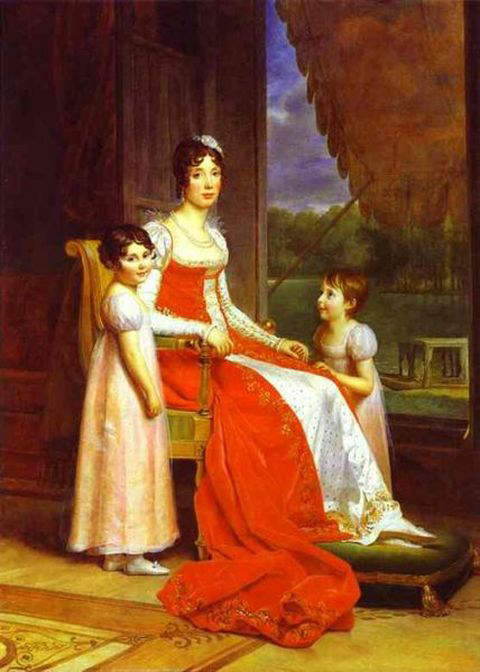
Julie Clary - Wife and Queen consort of Joseph Bonaparte, king of Spain from 1808 to 1813
Ornaments worn -
Double strand pearl necklace.
Drop-earrings with single drop-shaped pearl.
Hair ornament set with pearls.
Bangle bracelet on each hand.
Portrait by - Francois Pascal Simon Gerard in 1808
Isabella II - The first and only female monarch of Spain who ruled from 1833 to 1868
Isabella II was the first and only female monarch of Spain, who ascended the throne as an infant, soon after the death of her father King Ferdinand VII of Spain in 1833. Her mother, dowager Queen Maria Christina initially served as her regent, but was replaced by the army commander General Baldomero Espartero in 1840, who served as regent for the next two years. In 1843, Queen Isabella who was 13 years of age was declared by the government and the army to have attained the age to rule on her own.
Queen Isabella was maintained on the throne only by the support of the army and the political establishment, consisting of moderate liberals and the progressives, who re-established constitutional and parliamentary government. The military and political leaders arranged a marriage for the 16-year-old Queen and her younger sister, Infanta Luisa Fernanda, both marriages taking place on the same day, on October 10, 1846. While Queen Isabella married her double-first cousin, Francisco de Asis de Borbon, her younger sister married Antoine d'Orleans, Duke of Montpensier. Queen Isabella had twelve children by this marriage, out of which only five survived into adulthood.
During her reign the government was mostly under the control of Moderates, and Union Liberals. The Progressives were mostly kept out of power, sowing the seeds of discontent that led to the revolution of 1868. The Glorious Revolution of 1868 deposed Queen Isabella, who went into exile in France, joining her mother Maria Christina. After the revolution a provisional government and a regency was established, and the new Cortes decided to re-instate the monarchy under a new dynasty. Spain was then compelled to seek a monarch from one of the royal houses of Europe, who was willing to takeover the monarchy of Spain. After consultations the choice eventually fell on Amadeo from the royal House of Savoy of Italy, who as the Duke of Aosta was the founder of the Aosta branch of this house, and was elected King on November 16, 1870. The provisional government and regency ruled from October 8, 1868 to January 2, 1871. The Duke of Aosta, ascended the throne of Spain as Amadeo I, on January 2, 1871, swearing to uphold the constitution of Spain.
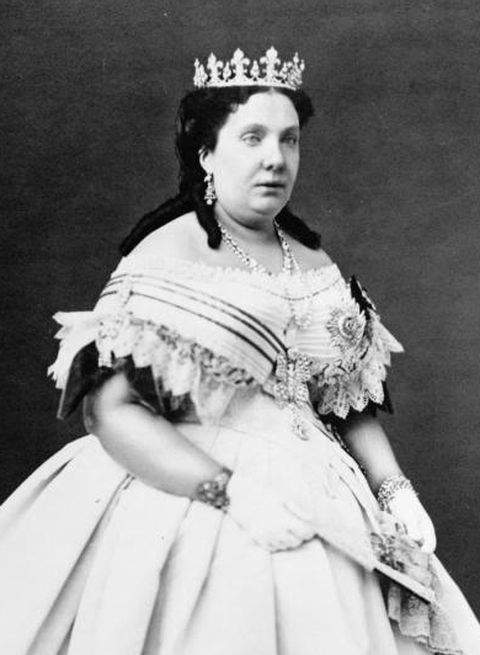
Photograph of Queen Isabella II of Spain
Ornaments worn -
Necklace set with colored stones and diamonds.
Stomacher set with spherical pearls.
Brooch set with colored stones and diamonds.
Bracelet on the right hand set with a cluster of pearls.
Bracelet on the left hand set with diamonds.
Drop-earrings set with diamonds and pearls.
Crown set with diamonds and pearls.
Maria Vittoria del Pozzo - First wife and Queen consort of Amadeo I, the only King of Spain from the House of Savoy
Amadeo I, the only king of Spain from the House of Savoy of Italy, ascended the throne of Spain on January 2, 1871. He was the second son of king Victor Emmanuel II of Italy and archduchess Adelaide of Austria. From the time of his birth on May 30, 1845, in Turin, Italy, he was given the title of Duke of Aosta. In 1867, Duke Amadeo at the age of 22, married the 20-year-old Donna Maria Vittoria del Pozzo, from a family of lesser nobility, but the sole heiress to a vast fortune left by her father. Soon after the election of Amadeo as king of Spain, his main backer General Juan Prim was assassinated and the new king was forced to deal alone with all the complexities of Spanish politics such as republican conspiracies, Carlist uprisings, separitism in Cuba, inter and intra party disputes, fugitive governments and assassination attempts. The climax came towards the end of 1872, when the artillery corps of the Army went on strike, and the King after issuing an order against the artillery corps on the instructions of the government, abdicated from the Spanish throne on February 11, 1873, declaring the Spanish people ungovernable. On the same night at 10 o'clock Spain was proclaimed a republic.
When Amadeo I ascended the throne of Spain on January 2, 1871, Maria Vittoria became the Queen consort of Spain. She led a discreet life as Queen of Spain, involving herself mainly in charity work. When Amadeo I abdicated the Spanish throne and returned to Italy, Maria Vittoria also accompanied her husband. She gave birth to her third child, Luigi Amadeo on January 29, 1873, just before her husband abdicated the Spanish throne. Maria Vittoria accompanied by her three children and husband returned overland to Turin in Italy, where she died in November, 1876, aged 29 years.
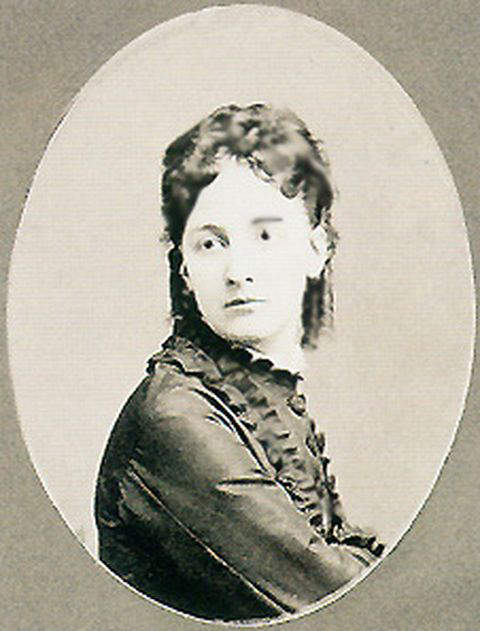
Maria Vittoria del Pozzo - First wife and Queen consort of Amadeo I
Ornaments worn -
The above black and white photograph of Maria Vittoria del Pozzo taken before 1876, show her wearing a simple long-sleeves dress.Any ornaments worn by her cannot be identified due to the nature of the photograph, and the lack of color contrast. Though the Queen does not seem to be wearing any earrings or necklaces, what looks like a pearl brooch can be seen on the upper front of the bodice of her dress.
Maria Letizia Bonaparte - Duchess of Aosta, and second wife of Prince Amadeo, Duke of Aosta, whom she married after he abdicated the Spanish throne.
After the death of Maria Vittoria in 1876, Prince Amadeo, the Duke of Aosta, remained unmarried for the next 12 years. In 1888, he met his niece Maria Letizia Bonaparte, the daughter of Princess Maria Clotilde of Savoy, his sister, and Napoleon Joseph Bonaparte, a nephew of Napoleon Bonaparte through his brother Jerome Bonparte, King of Westphalia. Prince Amadeo fell in love with her young and beautiful niece and proposed to marry her. She agreed and after Papal sanction was given to the uncle-and-niece marriage, they were married on September 11, 1888 at the Royal Palace of Turin in Italy. Amadeo was 43 and Maria Letizia 22 at the time of their marriage. Maria Letizia received a great number of valuable gifts for her wedding from relatives both from her side as well as her husband's side. Among the gifts received were some "great and illustrious" family jewels from Empress Eugenie, the widowed-wife of Napoleon III, and a seven-strand pearl necklace valued at 60,000 dollars from Prince Amadeo's three sons by his marriage to Maria Vittoria.
The couple lived in Turin, and had one son together, Prince Umberto, Count of Salemi, who was born on June 22, 1889. However, Maria Letizia was soon widowed just two years after her wedding, as Amadeus died in Turin, on January 18, 1890. Maria Letizia outlived her husband by 36 years and died in 1926 aged 60 years.
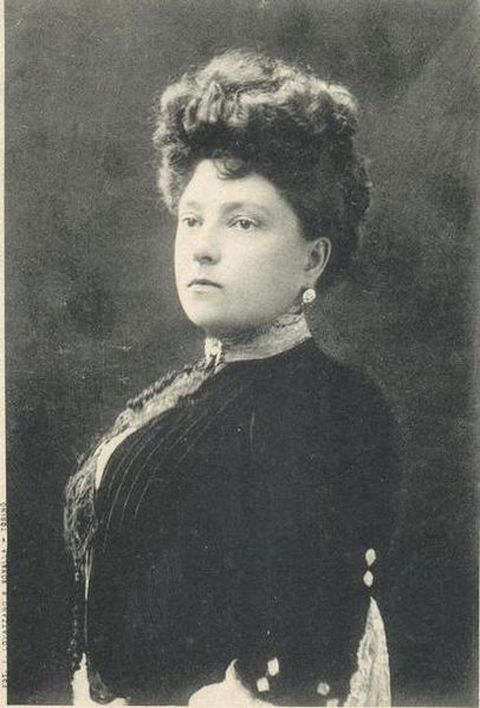
Maria Letizia Bonaparte- Duchess of Aosta and second wife of Prince Amadeo, Duke of Aosta
Ornaments worn -
The above photograph of Maria Letizia was taken in the late 19th-century. The Princess appears to be wearing some ornaments such as earrings, a brooch and a stomacher. However, the nature of these ornaments cannot be described due to the lack of color contrasts, and the sideways posture of the princess that seem to hide these ornaments. The earrings probably are set with a central pearl surrounded by diamonds.
Mercedes of Orleans - First wife (January 1878 - June 1878) and Queen consort of Alfonso XII, King of Spain from 1875 to 1885.
The first Spanish Republic that was declared on February 11, 1873, the same day king Amadeo I abdicated his throne, declaring the Spanish people ungovernable, lasted less than two years, perhaps confirming Amadeo I's pessimistic assessment of his former subjects. A coup d'etat in December 1874 restored the monarchy and ended the short-lived First Spanish Republic. Alfonso XII - the only surviving son of Queen Isabella II, in whose favor the exiled queen abdicated on June 25, 1870, in Paris, in the presence of several Spanish nobles - was proclaimed the new king of Spain on December 29, 1874, by Canovas del Castillo, who was appointed as regent by the coup leaders, until the arrival of the new king from the United Kingdom, where he was pursuing his military studies at the Royal Military Academy Sandhurst. Alfonso XII arrived in Madrid in early 1875 passing through Barcelona and Valencia and was given a rousing reception by people everywhere. At the time Alfonso XII ascended the throne he was 17 years old. One of the first assignments of the Sandhurst-trained young king, in which he himself took part was a concerted campaign against the Carlists, resulting in the defeat of Don Carlos, and the final end of the Carlist insurrection. Alfonso though young and without any experience in the art of ruling was naturally gifted, possessing great natural tact and sound judgement, that was woefully lacking in his predecessors. He had great ability in dealing with people and complex situations, and kept aloof of party politics, not allowing himself to be used as a pawn by any political party. He was successful in establishing peace both at home and the Spanish colonies abroad, and introduced sound financial and administrative management. He was benevolent and sympathetic towards his subjects and won their affection, when he fearlessly visited regions devastated by the earthquake of 1885, and areas affected by cholera epidemic during his rule. However, unfortunately the young king died of tuberculosis in November 1885, just before his 28th-birthday.
In 1876, after Alfonso XII was restored to the Spanish throne, the 19-year-old Alfonso declared his intention to marry his childhood sweetheart, his 16-year-old first cousin, Mercedes, with whom he fell in love when both their families (families of Isabella II and her sister Luisa Fernanda, Duchess of Montpensier) were living in exile in France after the 1868 glorious revolution. After an engagement that took place at a huge ball in December 1877, Alfonso XII married Mercedes d'Orleans at the Church of Atocha in Madrid on January 23, 1878. The wedding and the celebrations associated with it was one of the most popular in the history of Spain. However, shortly after their honeymoon, it became clear that Mercedes was suffering from the killer disease tuberculosis. The desperate king could not do anything to prevent his beloved wife's death and Queen Mercedes succumbed to her illness just five months after her marriage on June 26, 1878, two days after her 18th-birthday.
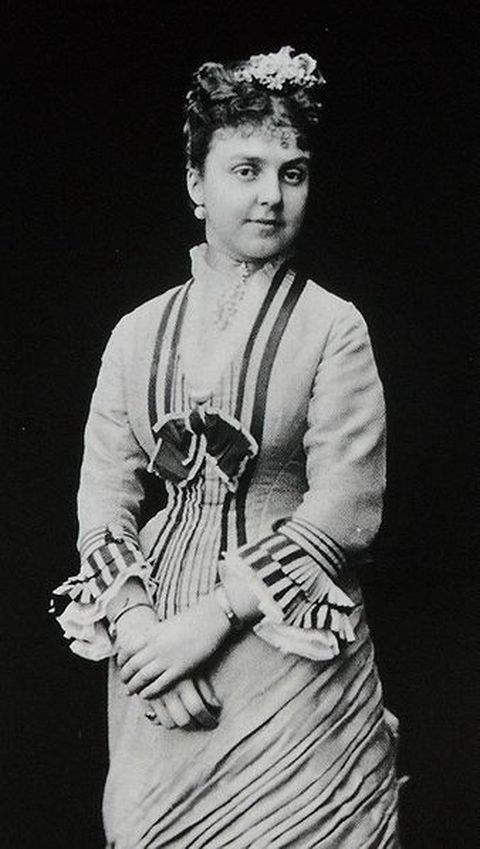
Merceded of Orleans - First wife and Queen consort of Alfonso XII, king of Spain from 1875 to 1885
Ornaments worn -
Due to lack of color contrasts it is difficult to describe the ornaments worn by Queen Mercedes in the above black and white photograph taken in the late-19th century. However, the drop earrings she is wearing appear to be set with a spherical pearl. A stomacher or brooch she is wearing also appears to be set with white spherical pearls. She is also wearing bangle bracelets around her wrists and rings on the small finger of her right hand.
Maria Christina of Austria - Second wife (1879-1885) and Queen consort of Alfonso XII, king of Spain from 1875 to 1885
The death of his first wife, Mercedes devastated King Alfonso XII, who was encouraged by his prime-minister Canovas del Castillo to take as his second wife, the younger sister of Mercedes, Maria Cristina, who resembled Mercedes in many ways. King Alfonso XII agreed but unfortunately she too died of tuberculosis during the engagement period. The king was totally devastated and heartbroken by the double-tragedy, that left him without any zest for his own life. Yet, by the end of that year he was persuaded again to re-marry,and this time he chose a more distant relative, Maria Christina of Austria, daughter of Archduke Karl Ferdinand of Austria and his wife Archduchess Elizabeth of Austria. They married on November 29, 1879, at the Basilica of Atocha in Madrid. Christina was 21 and Alfonso 22 at the time of their marriage.
The marriage produced two children in quick succession, both daughters, one in September 1880 named Maria de las Mercedes and the other in November 1882, named Maria Teresa. Maria Christina again became pregnant three years later, around August 1885, but King Alfonso XII died the same year in November, when his Queen consort was three months pregnant. Thus, the Spanish throne had to remain vacant until Maria Christina gave birth to her third child posthumously, because the succession laws of Spain, gave priority to a male child in succession, and the eldest female child could ascend the throne only in the absence of any male issue. During this period Maria Christina served as regent. On May 17th 1886, Queen Maria Christina gave birth posthumously to a son, who was proclaimed king of Spain immediately after his birth, with the title Alfonso XIII of Spain. His mother Queen Maria Christina was appointed regent during his minority. She continued her regency until her son Alfonso XIII attained his majority in 1902, when he turned 16. Her 16-year regency was described as well-balanced, with respect for constitutional rights and political reforms that minimized political conflicts and chaos. When Alfonso XIII got married in 1906 his wife, Victoria Eugenie of Battenburg became the Queen consort and the first-lady at court, and Maria Christina became the Queen Dowager. Maria Christina died in 1929, at the age of 71 years.
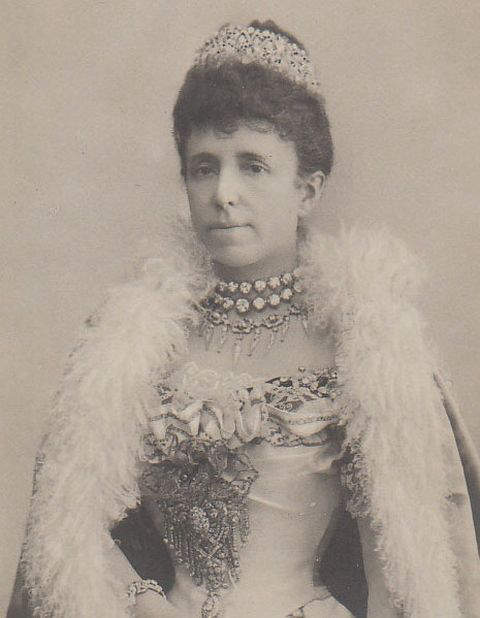
Maria Christina of Austria - Second wife and Queen consort of Alfonso XII, king of Spain from 1875 to 1885
Ornaments worn -
Hair ornament set with diamonds, colored stones and perhaps also pearls.
Two strand necklace set with old cut diamonds.
Fringe necklace incorporating diamonds and pearls.
Elaborate stomacher set with diamonds.
Diamond bracelet.
Victoria Eugenie of Battenburg - Wife and Queen consort of Alfonso XIII, king of Spain from 1886 to 1931
Alfonso XIII, the posthumous son of Alfonso XII was proclaimed King of Spain at his birth on May 17, 1886. His mother, Queen Maria Christina, acted as regent during his minority. King Alfonso XIII assumed full control of his kingdom when he attained 16 years in 1902, an event that was marked by weeklong celebrations, that included bullfights, balls and receptions throughout Spain.
Although Alfonso XIII's reign began well, he did not possess the natural talents of his father and predecessor, Alfonso XII, such as great natural tact, sound judjement, great ability in dealing with people and complex situations, that ushered in an era of peace and stability, both at home and the overseas Spanish colonies. On the contrary, during his rule political divisions in the country deepened and Spanish society became deeply polarised into two opposing camps, the Republicans and the Nationalists, both of whom were not keen in retaining the monarchy, though it was more constitutional than absolute. Spain also lost its last colonies, Cuba and Puerto Rico in the Caribbean and Philippines in the Far-East, during his reign. Among the positive ahievements of his rule were, keeping Spain neutral during World War I, promotion of tourism in Spain, and his patronage for the development of football clubs such as Real Madrid. Spain's neutral stand in the war played a crucial role that enabled the Spanish diplomatic network abroad to intercede for thousands of prisoners-of-war and for receiving and answering letters from Europe. At a time when strict news censorship was in force in the countries of Europe embroiled in the war, Spain became the main source of not only war-related news to the outside world, but also other important happenings, such as the flu pandemic of 1918, in which Alfonso XIII himself became a victim but miraculously recovered, the pandemic itself receiving the misnomer "Spanish Flu" though Spain was not among the most affected countries.
In 1905, just three years after he attained majority, the 19-year-old King Alfonso III paid an official visit to the United Kingdom, where he met for the first time his future bride, the 18-year-old Princess Victoria Eugenie, daughter of Prince Henry of Battenburg and his wife Princess Beatrice of the United Kingdom, at a dinner hosted by King Edward VII in the Buckingham Palace in his honor. King Alfonso, who was enamored with Princess Victoria Eugenie, kept in constant touch with her after he returned to Spain. In January 1906, King Alfonso's mother, Maria Christina having finally agreed to her son's choice, made contact with Victoria Eugenie's mother Princess Beatrice, informing her about the love Alfonso felt for her daughter and seeking her hand for her son. Princess Beatrice sought her brother, King Edward's approval for the marriage, and after it was granted both mother and daughter travelled to Spain, where they met King Alfonso and his mother, Queen dowager Maria Christina. Arrangements were made for the formal conversion of Victoria Eugenie from the Anglican to the Catholic faith, which was necessary if she was to become the future Queen of Spain. By doing so, Princess Beatrice forfeited any succession rights, however remote, to the British crown, according to the Act of Settlement, that prevented Roman Catholics from ascending the British throne. Prior to her marriage, King Edward VII issued a royal warrant on April 3, 1906, that elevated Princess Victoria Eugenie's standing from "Her Highness" to "Her Royal Highness" as soon she was expected to become the spouse and Queen consort of the King of Spain.
The marriage of H.R.H. Princess Victoria Eugenie to King Alfonso of Spain took place on May 31, 1906 at the Royal Monastery of San Geromino, in Madrid, Spain. Queen Victoria Eugenie's tenure as Queen of Spain had a rather inauspicious beginning, as it was marred by an assassination attempt on the newly married royal couple, when a bomb was thrown at the royal carriage from a balcony, as the royal procession was returning to the palace after the wedding ceremony. The explosion killed many innocent bystanders and members of the royal procession, but the King and Queen were miraculously unhurt.The incident served as a harbinger of what lay in store for the royal family in the future in Spain. Their marriage however, was successful producing seven children, five sons and two daughters. Out of the five sons the 3rd was stillborn, and the first and the last were haemophiliacs, a genetic abnormality in which females are carriers and the disease is shown only in males, referred to by geneticists as sex-linked inheritance. Queen Victoria Eugenie was a carrier, and she inherited the defective gene, through her mother, Princess Beatrice, who inherited it from her mother Queen Victoria, both Princess Beatrice and Queen Victoria being carriers. Both haemophiliacs died young, the eldest Infante Don Alfonso at 31 and the youngest Infante Don Gonzalo at 19, coincidentally due to bleeding injuries suffered in car crashes. The 2nd-son Infante Don Jaime became a deaf-mute as a result of a childhood operation, and renounced his rights to the throne because of his infirmities. Thus, the 4th-son, Infante Don Juan, who was a normal healthy child became the heir-apparent to the Spanish throne, and was given the title Prince of Asturias in 1933, but preferred to use the title Count of Barcelona.
As Queen of Spain, Princess Victoria Eugenie devoted most of her time, working for hospitals, providing social services for the poor and helping in the field of education. She was also involved in the reorganization of the Spanish Red Cross.
On April 14, 1931, the Second Spanish Republic was proclaimed following sweeping election victories achieved by the Republicans in the municipal elections held in major cities. In the hope that his voluntary exile might avert a civil war between the Republicans and the Nationalists, King Alfonso III decided to go into exile with his family, immediately after the proclamation of the Second Republic. They first went to France, from where they moved to Rome in Italy, living in the Grand Hotel. Queen Victoria Eugenie then moved to U.K. for a short period leaving her husband in Rome. From the U.K. she moved to Switzerland, where she purchased a chateau, the Vieille Fontaine outside of Lausanne. A family re-union took place in 1938, when the whole family gathered in Rome for the baptism of Juan Carlos, the eldest son of the Count of Barcelona, Don Juan de Borbon. Alfonso XIII abdicated his rights to the Spanish throne in favor of his son, Don Juan de Borbon, on January 15, 1941. He died of a heart attack, in Rome on February 28, 1941, aged 55 years. Queen Victoria Eugenie outlived her husband by 27 years, dying in Lausanne in 1969, aged 81 years.
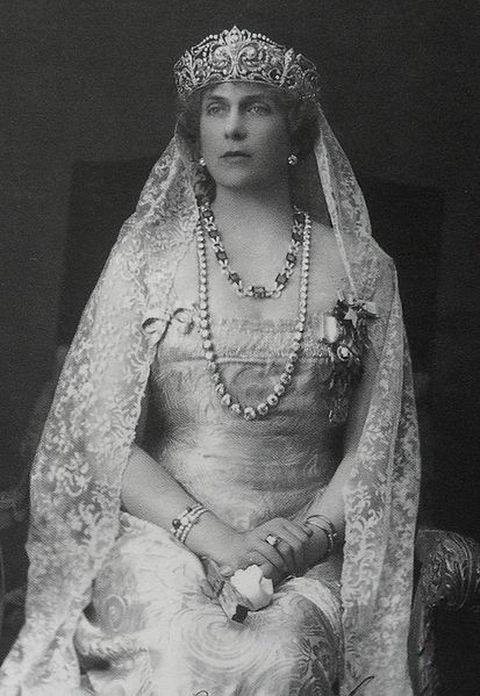
1922-Photograph of Victoria Eugenie of Battenburg - Wife and Queen consort of Alfonso XIII, king of Spain from 1886 to 1931
Ornaments worn-
Crown, probably set with pearls and diamonds.
Link-necklace set with colored stones, probably emeralds.
A second longer necklace probably made of corals or pearls.
Triple-strand bracelet on the right hand, probably made of pearls and colored stones.
Pair of cluster earrings.
An elaborate brooch on the left side of the bodice of her dress.
Proclamation of the Second Republic (1931-1936) and the Spanish Civil war (1936-1939)
After the proclamation of the Second Republic by the Republicans, on April 14, 1931, a Popular Front government was formed, consisting apart from Republicans, other anti-monarchist factions such as the Socialists and Communists. This government did not enjoy the support of the main political faction, the Nationalists, and others such as the Conservatives, Monarchists and Fascists and more importantly the military. The country became deeply polarised and divided, parts of the country coming under the control of the Nationalists and the remaining parts under the Republicans. The stage was now set for a showdown between the two factions. Civil war broke out between the two factions, with a military uprising against the Popular Front Government. Alfonso, living in exile in France, declared that he favored the military uprising against the Popular Front government, but General Francisco Franco declared in September, 1936, that the Nationalists would never accept Alfonso as king. International meddling in the civil war saw the Soviet Union headed by Joseph Stalin, supporting the anti-monarchist factions-the Republicans, the Socialists and the Communists, and neighbouring Portugal, Fascist Italy and Nazi Germany supporting the Nationalists, Monarchists, and Conservatives.
Dictatorship of General Francisco Franco (1939-1975)
On October 1, 1936, General Francisco Franco was proclaimed Head of State, in the parts of Spain controlled by the Nationalists. The civil war ended in 1939, the Nationalists supported by the Monarchists and Conservatives emerging victorious, over the Republicans, Socialists and Communists. When the civil war ended on April 1, 1939, General Franco took control of the entire country, as an absolute dictator, agreeing to a restoration of the monarchy only after his death. The legal heir to the Spanish throne was Don Juan de Borbon, who was made the Prince of Asturias in 1933, and his rights to the Spanish throne being confirmed, on January 15, 1941, when Alfonso XIII living in exile in Rome, abdicated in his favor. However, General Franco viewed the heir to the throne with great suspicion, believing him to be a liberal opposed to his regime, and decided to skip a generation, naming Don Juan' son Juan Carlos as his personal successor. In 1969, Juan Carlos was officially designated the heir to the Spanish throne and given the new title "Prince of Spain" instead of the traditionl "Prince of Asturias." Since then Juan Carlos often took part in official and ceremonial state functions alongside the dictator, and publicly supported General Franco's regime, earning his trust and confidence. Without betraying this trust Juan Carlos also had discussions with leaders of the political opposition and exiles, including his father. Juan Carlos served as acting head-of-state in 1974 and 1975 when General Franco was temporarily incapacitated. As his condition further deteriorated General Franco gave full control of the country to Juan Carlos, on October 30, 1975. General Franco died on Novmber 22, 1975, and immediately after his death Juan Carlos was proclaimed King of Spain
Restoration of the monarchy and ascendancy of Juan Carlos as king of Spain - The reigning king of Spain (1975 - present)
Juan Carlos I though the personal choice of the dictator General Franco, eventually turn out to be the popular choice of the people of Spain. Like his great-grandfather King Alfonso XII, Juan Carlos was naturally gifted, possessing great natural tact and sound judgement and the ability to deal with people and complex situations. He began by quickly instituting political reforms, appointing former nationalist leader, Adolfo Suarez as Prime Minister, and bringing the socialists and communists into the mainstream politics of the country, thereby gaining their endorsement for the monarchy. He gained total legitimacy as the King of Spain in May 1977, when his father Don Juan de Borbon formally renounced his claim to the throne, and recognized his son, Juan Carlos as the sole head of the Spanish Royal House. He held Spain's first post-Franco democratic elections in June 1977. He initiated the drafting of a new constitution for Spain, that was approved by a democratically elected Constituent Cortes, and subsequently ratified by the people in a referendum, on December 6, 1978. Under this new constitution, the role of the Spanish monarch as the personification and embodiment of the Spanish nation, and a symbol of Spain's enduring unity and permanence is affirmed. Under the system of government introduced by the constitution known in Spanish as "monarquia parlamentaria" (parliamentry monarchy), the monarch is the head-of-state and commander-in-chief of the armed forces, but he plays a ceremonial role, political power being vested in the parliament and the prime minister. His greatest triumph came in February 1981, when he successfully foiled a coup attempt by a section of the military, by making a public television broadcast, calling for wholehearted support for the legitimate democratic government. The collapse of the attempted coup tremendously increased the popularity of the king and public support for the monarchy.
Opinion polls conducted since year 2000, had shown high approval ratings by Spaniards for King Juan Carlos. As King of Spain Juan Carlos also serves as the president of the Iberio-American States Organization, that brings together 24 former Spanish colonies worldwide, representing over 700 million people. Today, he is undoubtedly the most popular leader among the entire Iberio-American nations. Thus, King Juan Carlos gets the credit for successfully steering his nation, Spain, from a dictatorship to a parliamentary democracy.
Queen Sofia of Spain - Wife and Queen consort of King Juan Carlos I of Spain (1975 - present)
On May 14, 1962, King Juan Carlos married Princess Sophia of Greece and Denmark, the eldest daughter of King Paul of Greece and his wife Queen Frederica of Hanover, and sister of the deposed king Constantine II of Greece. The marriage was solemnized in the Church of Saint Dennis in Athens, and prior to the marriage she was converted from the Greek Orthodox religion to Roman Catholicism. In 1969, when Juan Carlos was officially designated as heir to the Spanish throne, by General Franco, and given the title "Prince of Spain," Sofia became the "Princess of Spain." When Juan Carlos ascended the throne of Spain as King Juan Carlos in 1975, she became the Queen consort of Spain. The marriage produced three children, two daughters and a son. As Queen consort she accompanies her husband on official duties both within Spain and abroad. She also takes a keen interest in social and charitable activities, and is the honorary president of the Royal Board on Education and Care of Handicapped Persons, and the Foundation for Aid for Drug Addicts. Her special interest in the internationl campaign aginst drug addiction is well known, and she had taken an active part in conferences against drug addiction both in Spain and abroad. She is also closely identified with the concept of Grameen Banking intiated by Dr. Muhammad Yunus of Bangladesh, that offers microcredit to rural women, and had travelled to Bangladesh, Chile, Columbia, El-Salvador and Mexico in support of the activities of the organization led by Dr. Yunus.
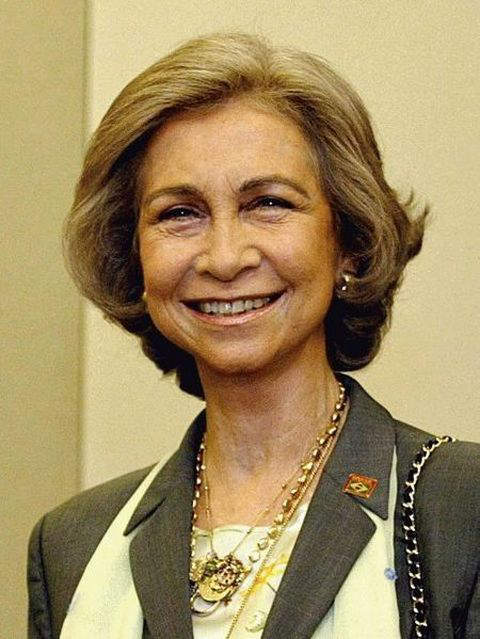
Queen Sofia of Spain - Wife and Queen consort of King Juan Carlos I of Spain
Photograph produced by - Ricardo Stuckert/Agencia Brasil
The Use and Appreciation of Pearls by the Monarchies of Portugal in the Middle Ages and until Modern Times
The use and appreciation of pearls by the monarchies of Portugal in the middle ages and thereafter will be considered in detail in the next webpage - "History of the Discovery and Appreciation of Pearls - Page 9."
You are welcome to discuss this post/related topics with Dr Shihaan and other experts from around the world in our FORUMS (forums.internetstones.com)
Related :-
1) History of the discovery & appreciation of Pearls- Part 1
2) History of the discovery & appreciation of Pearls- Part 2
3) History of the discovery & appreciation of Pearls- Part 6
4) History of the discovery & appreciation of Pearls- Part 7
References :-
1) Queen Sofia of Spain - From Wikipedia, the free encyclopedia.
2) Juan Carlos I of Spain - From Wikipedia, the free encyclopedia.
3) Victoria Eugenie of Battenburg - From Wikipedia, the free encyclopedia.
4) Maria Christina of Austria - From Wikipedia, the free encyclopedia.
5) Mercedes of Orleans - From Wikipedia, the free encyclopedia.
6) Maria Letizia Bonaparte - From Wikipedia, the free encyclopedia.
7) Maria Vittoria dal Pozzo - From Wikipedia, the free encyclopedia.
8) Isabella II of Spain - From Wikipedia, the free encyclopedia.
9) Julie Clary - From Wikipedia, the free encyclopedia.
10) Maria Christina of the Two Sicilies - From Wikipedia, the free encyclopedia.
11) Maria Josepha of Saxony - From Wikipedia, the free encyclopedia.
12) Maria Isabel of Portugal - From Wikipedia, the free encyclopedia.
13) Princess Maria Antonia of Naples and Sicily - From Wikipedia, the free encyclopedia.
14) Maria Luisa of Parma - From Wikipedia, the free encyclopedia.
15) Maria Amalia of Saxony - From Wikipedia, the free encyclopedia.
16) Barbara of Portugal - From Wikipedia, the free encyclopedia.
17) Louise Elisabeth d'Orleans - From Wikipedia, the free encyclopedia.
18) Elisabeth Farnese - From Wikipedia, the free encyclopedia.
19) Maria Luisa of Savoy - From Wikipedia, the free encyclopedia.
20) Maria Anna of Palatinate Neuburg - From Wikipedia, the free encyclopedia.
21) Marie Louise d'Orleans - From Wikipedia, the free encyclopedia.
22) Mariana of Austria - From Wikipedia, the free encyclopedia.
23) Elizabeth of France - From Wikipedia, the free encyclopedia.
24) Margaret ofAustria - From Wilipedia, the free encyclopedia.
25) Anna of Austria - From Wikipedia, the free encyclopedia.
26) Elizabeth of Valois - From Wikipedia, the free encyclopedia.
27) Queen Mary I of England - From Wikipedia, the free encyclopedia.
28) Maria Manuela of Portugal - From Wikipedia, the free encyclopedia.
29) Isabella of Portugal - From Wikipedia, the free encyclopedia.
Powered by Ultra Secure
Amazon (USA) Cloud Network

Founder Internet Stones.COM
Register in our Forums
| Featured In
|
|
|
|
|
|
|
|


















